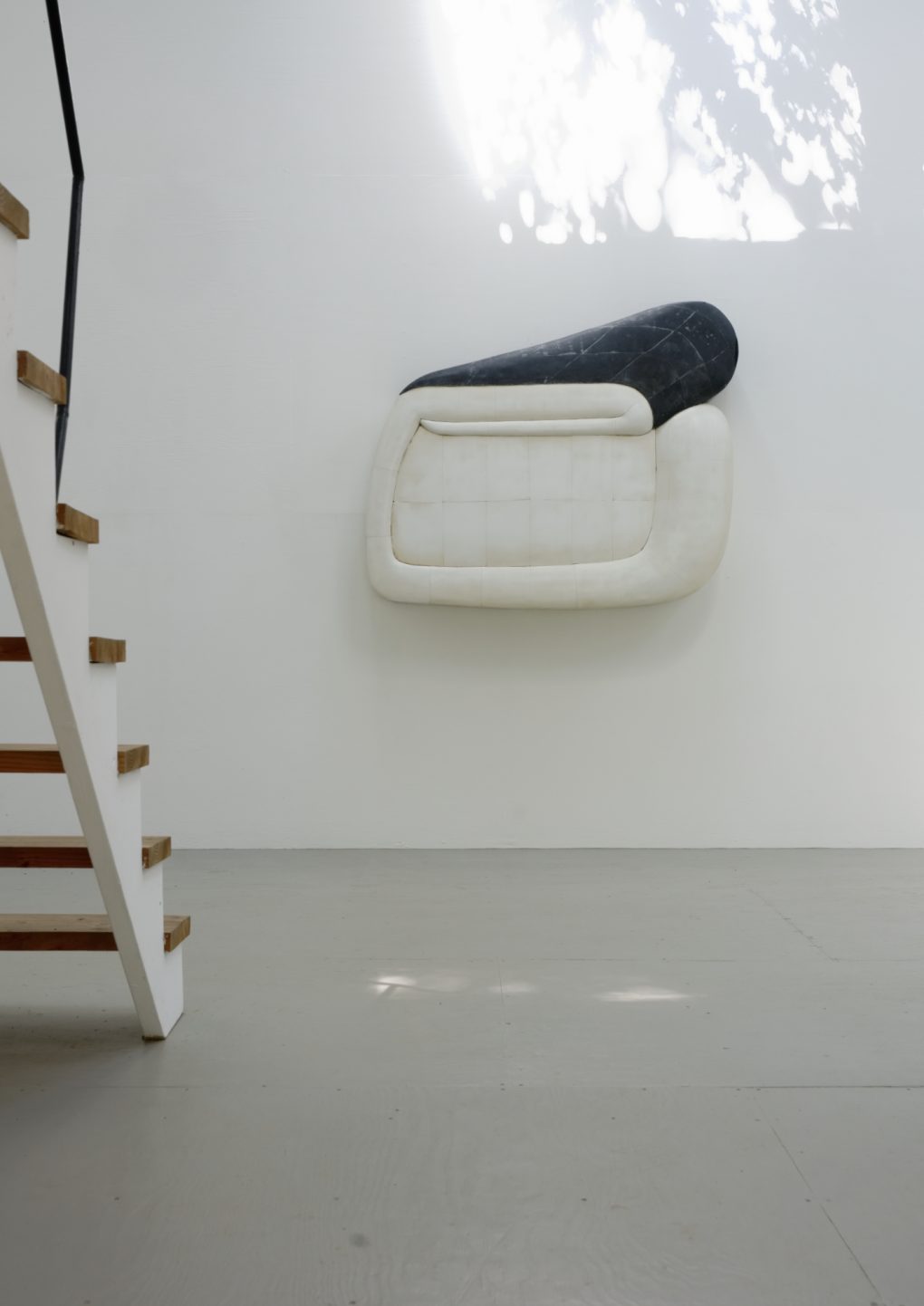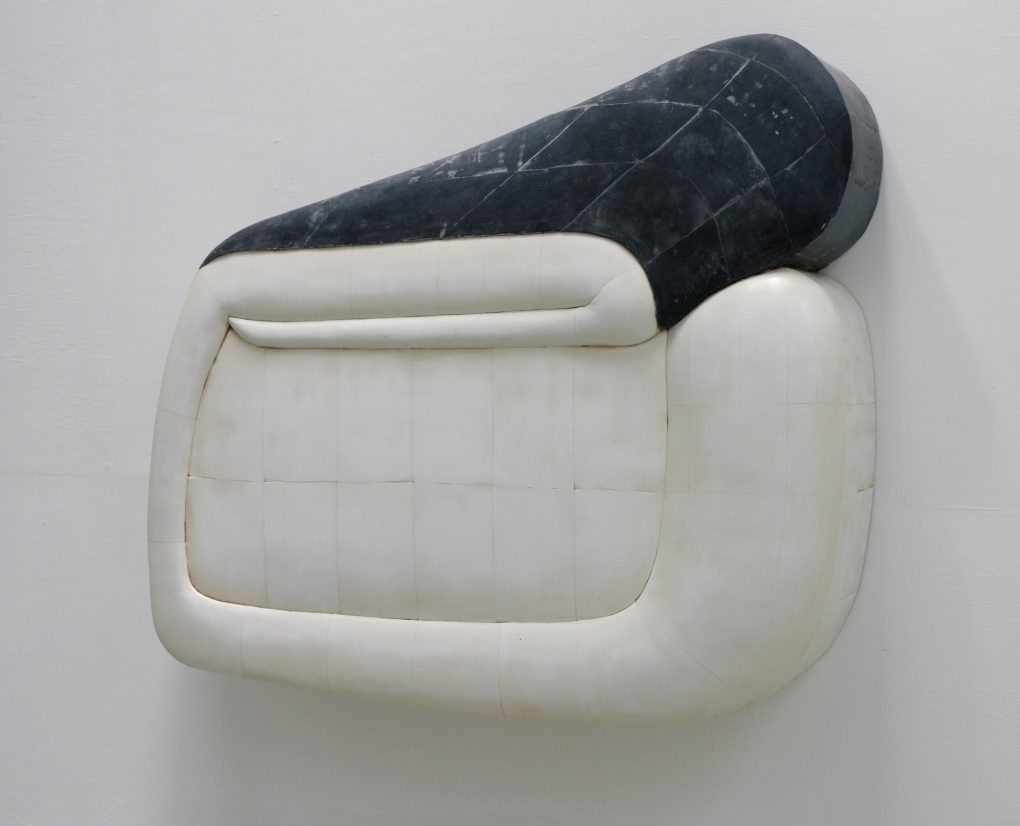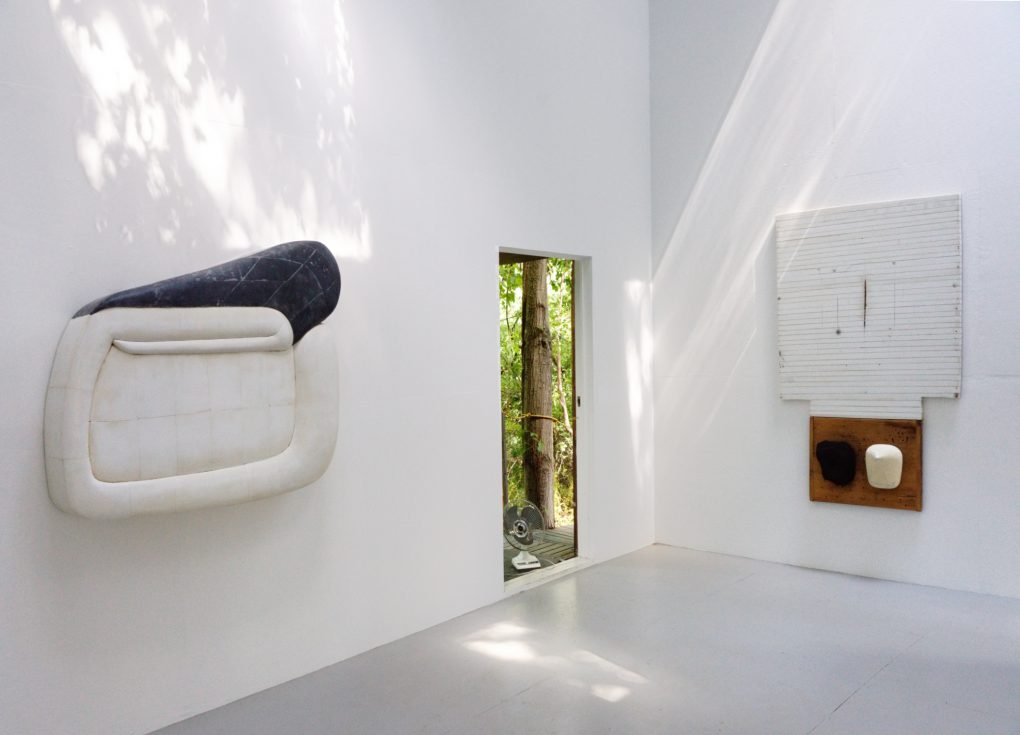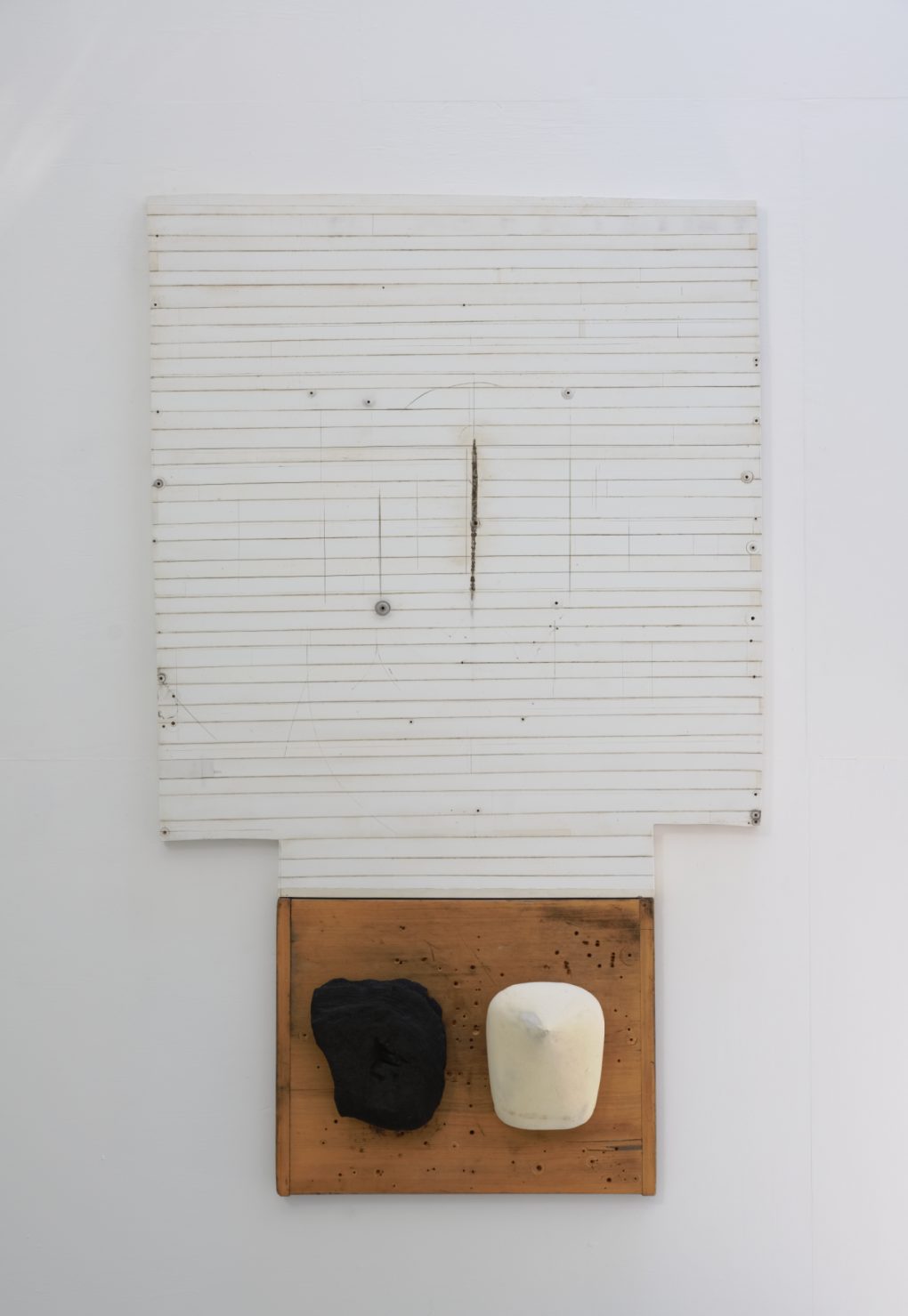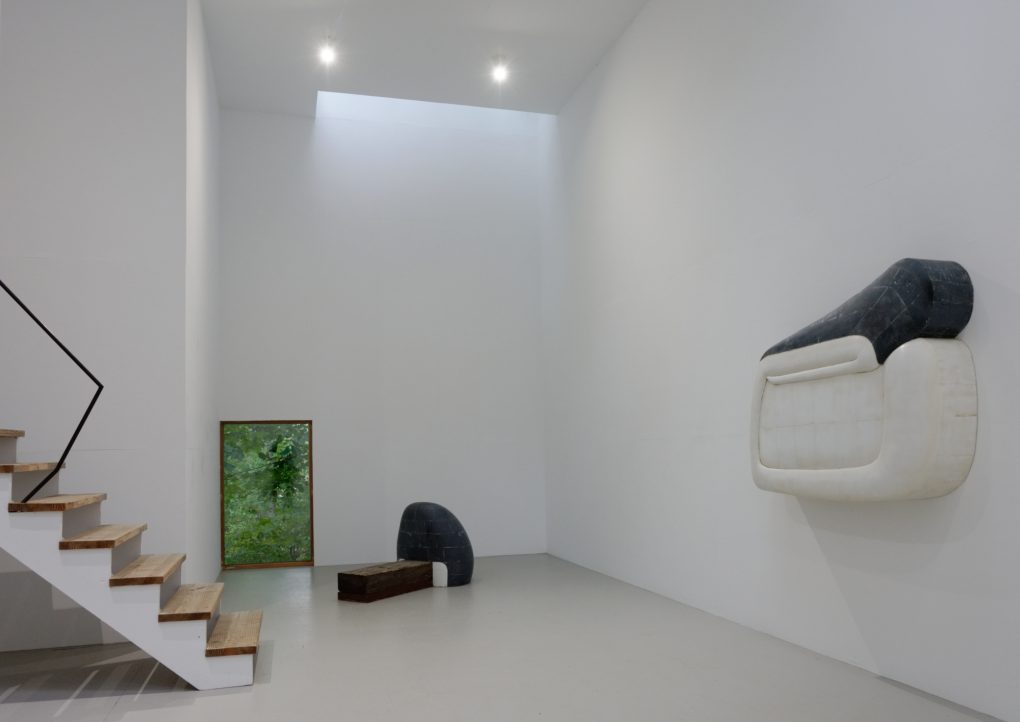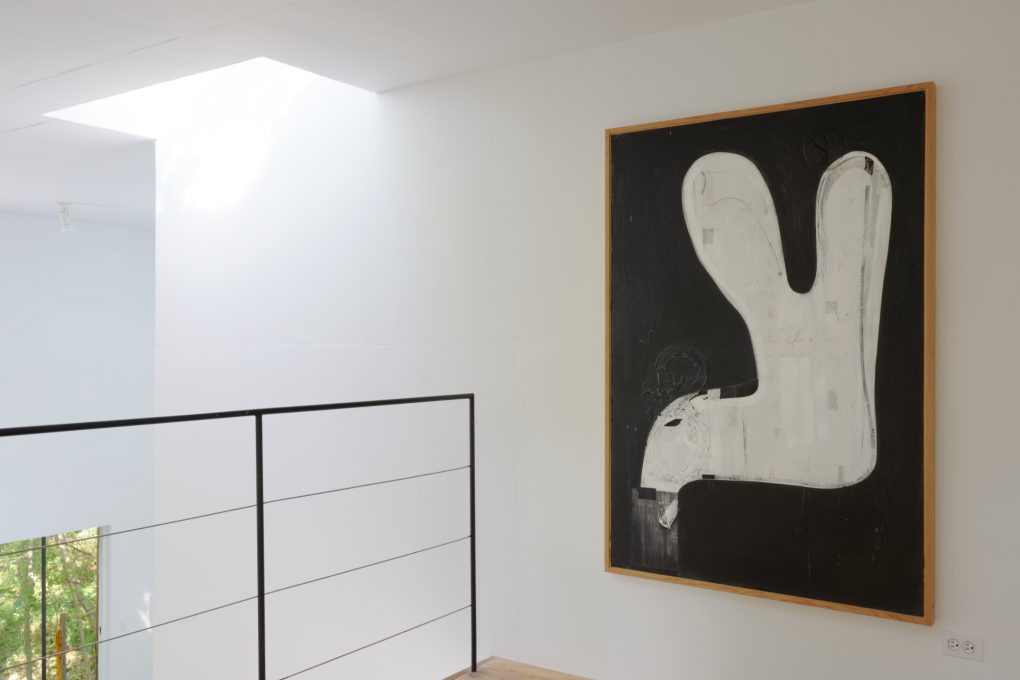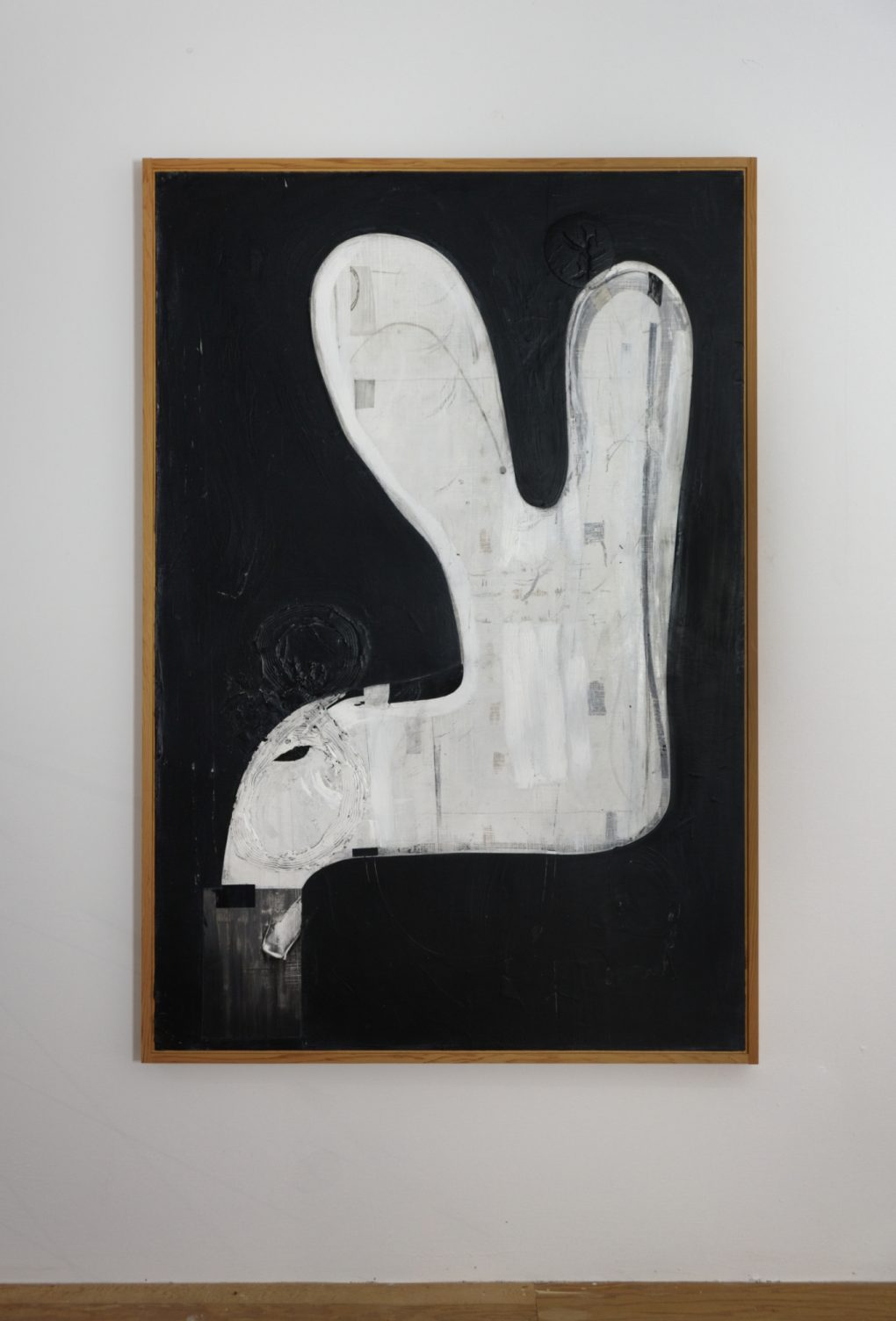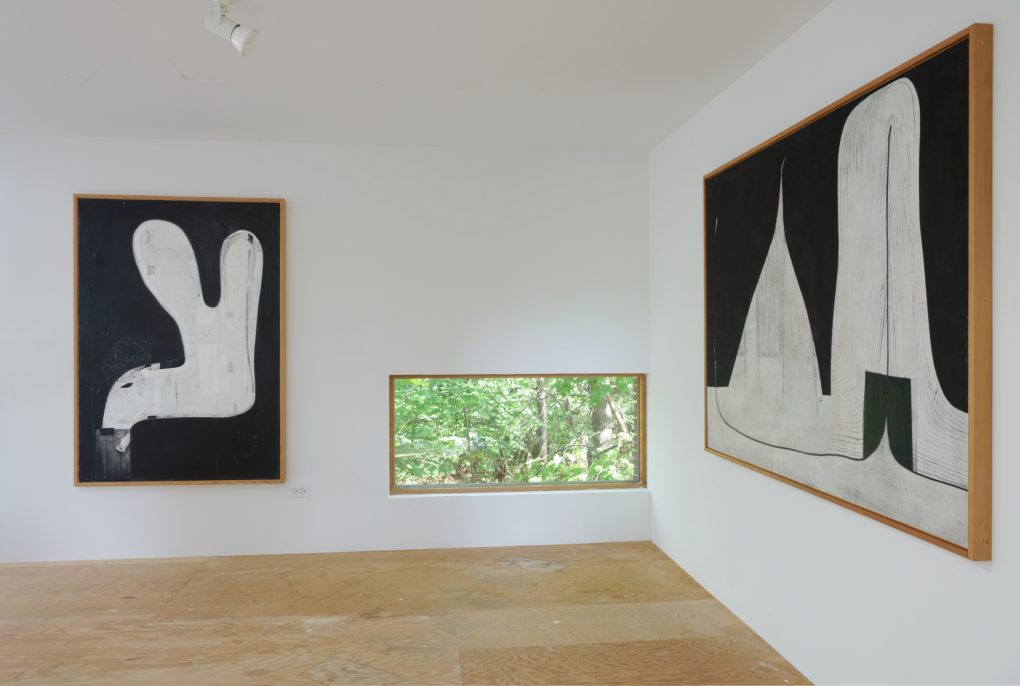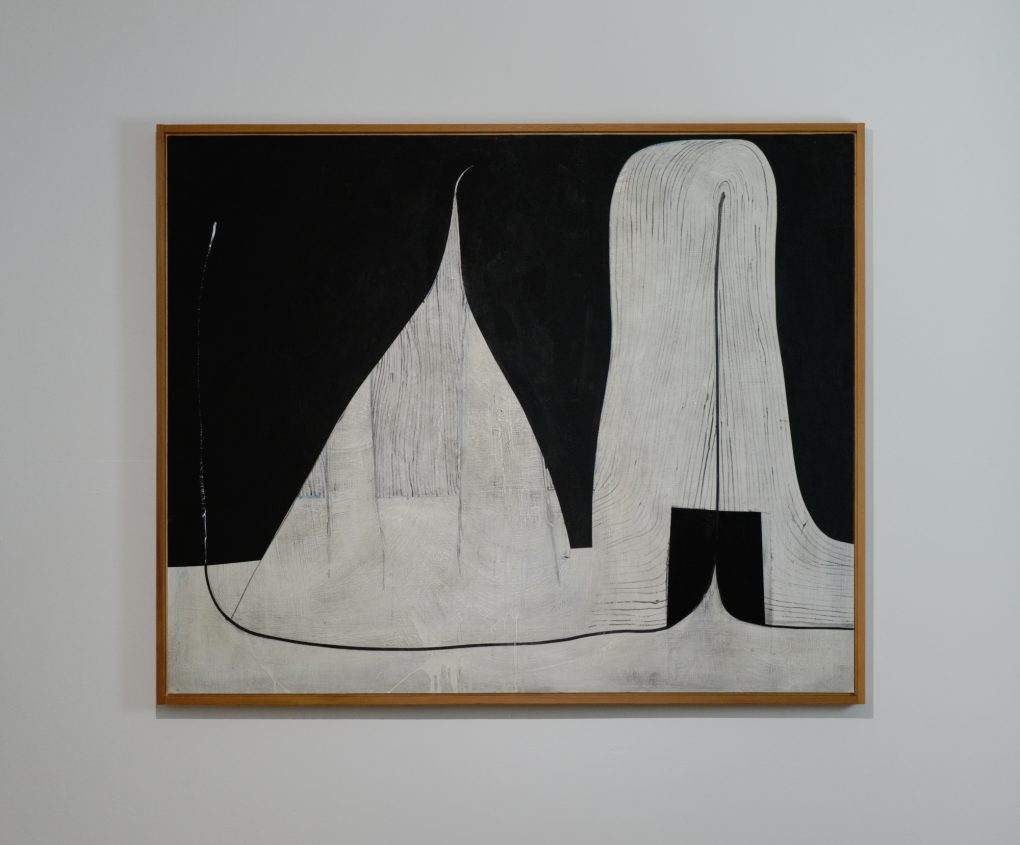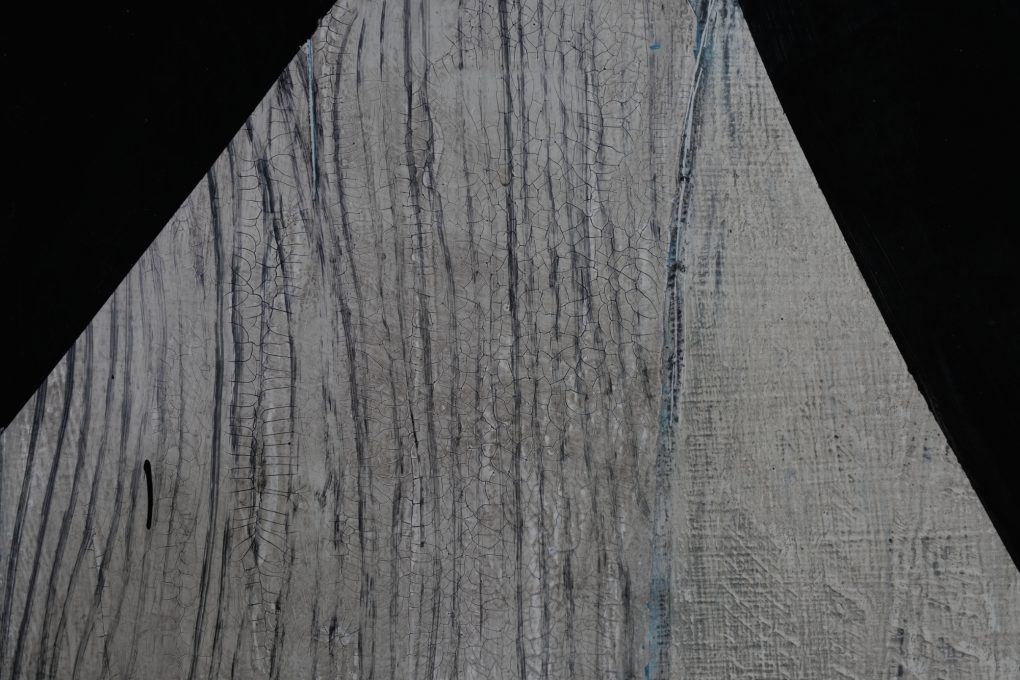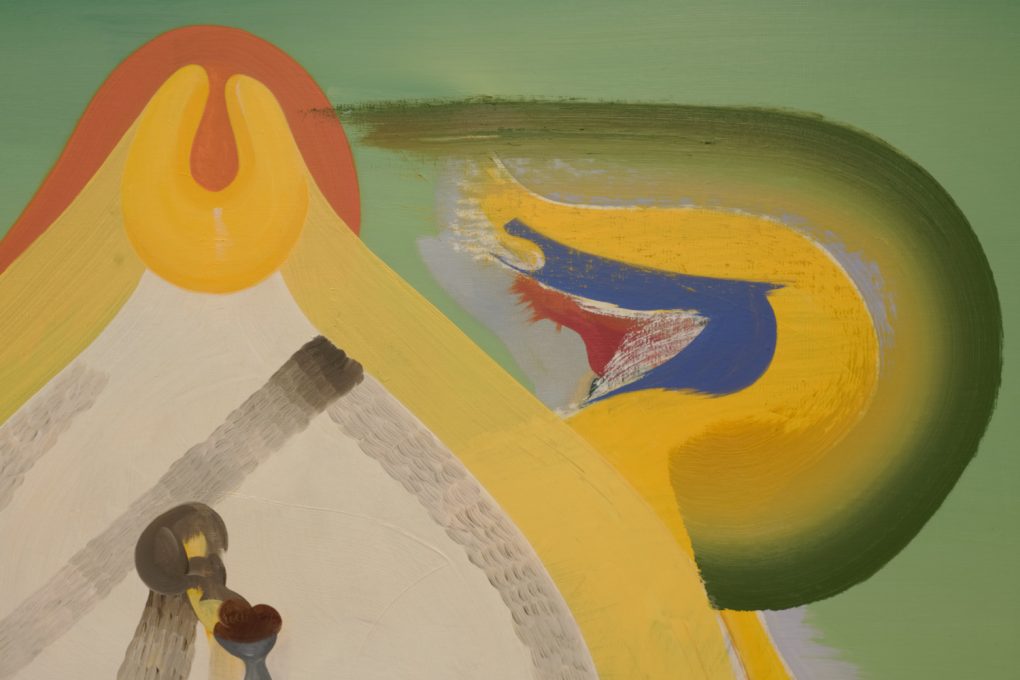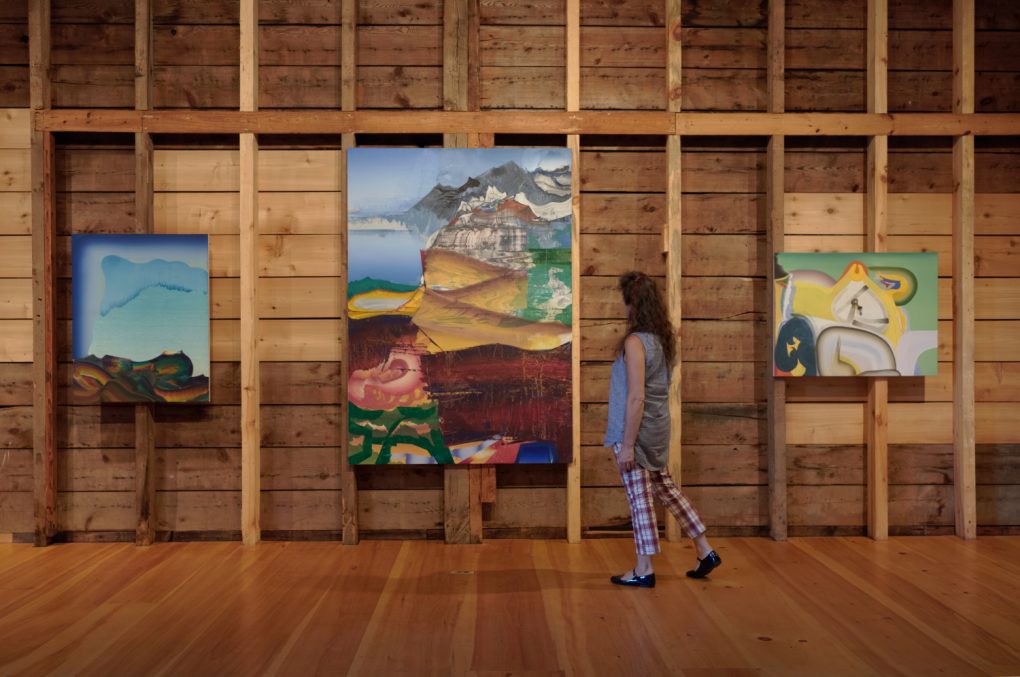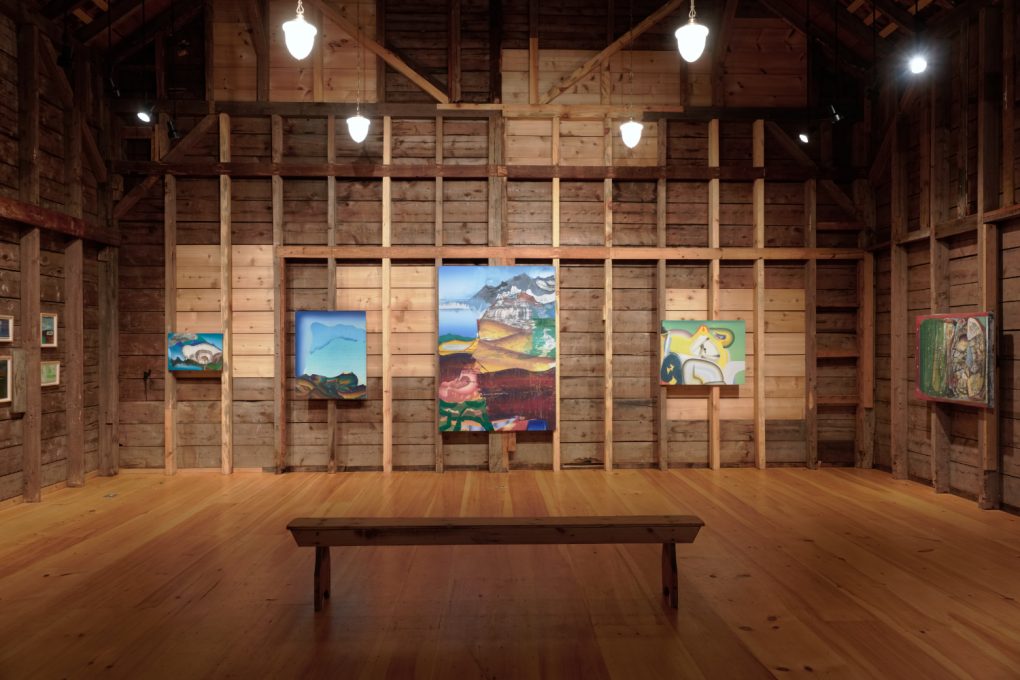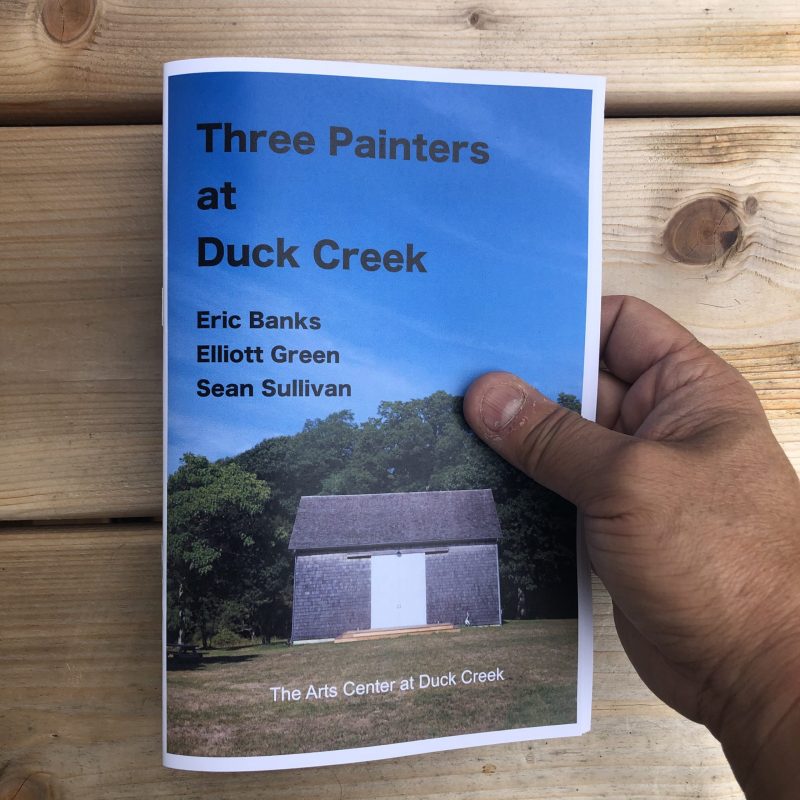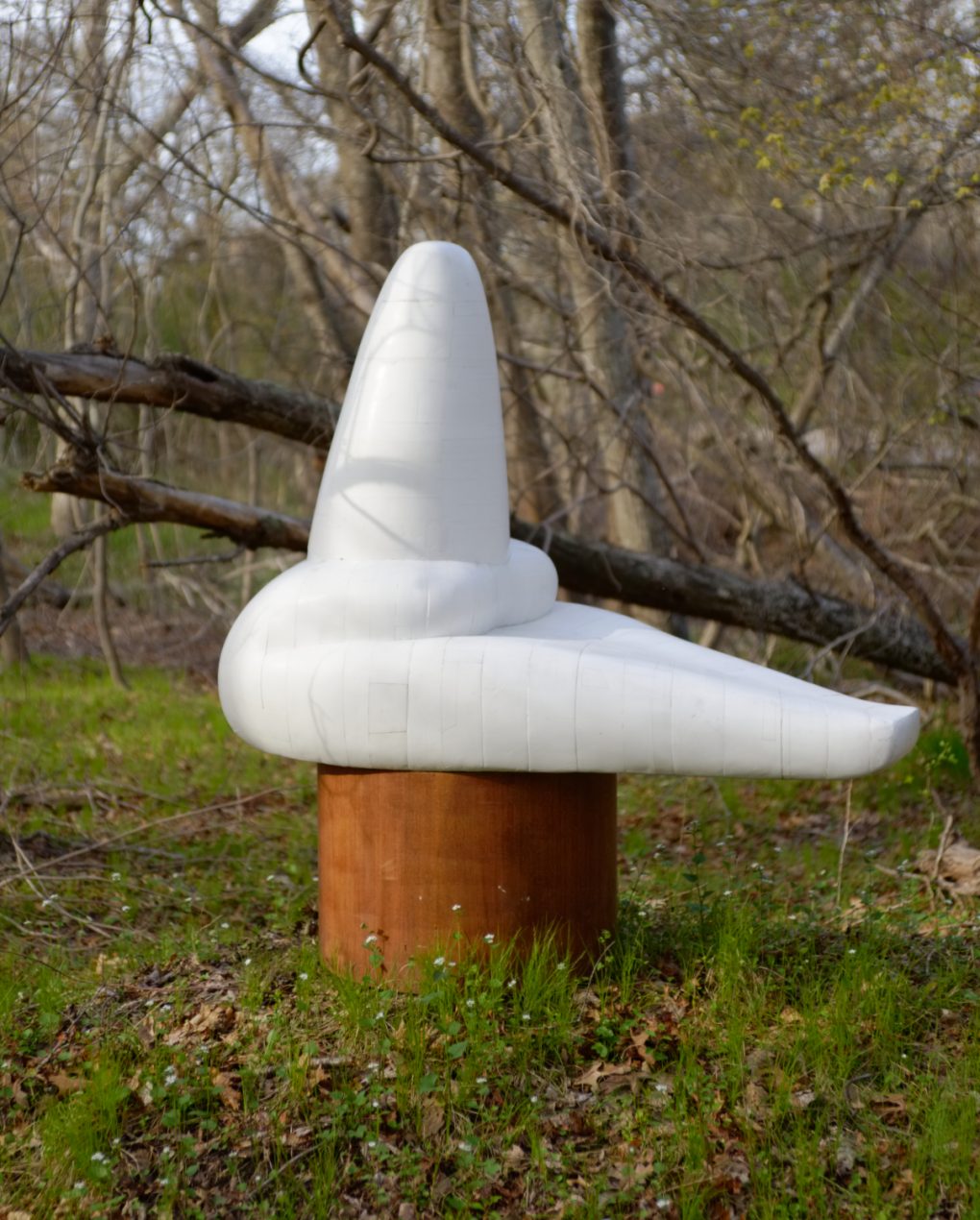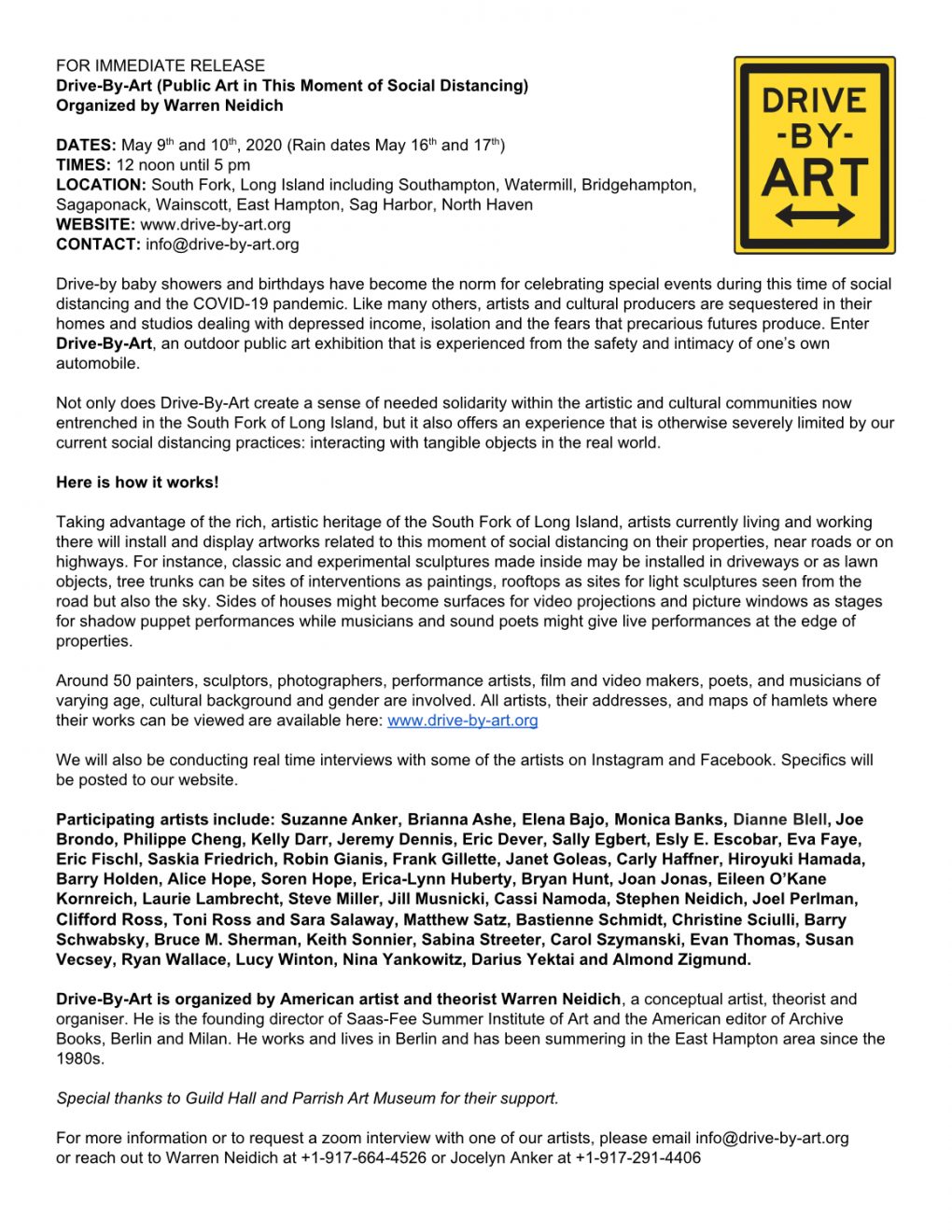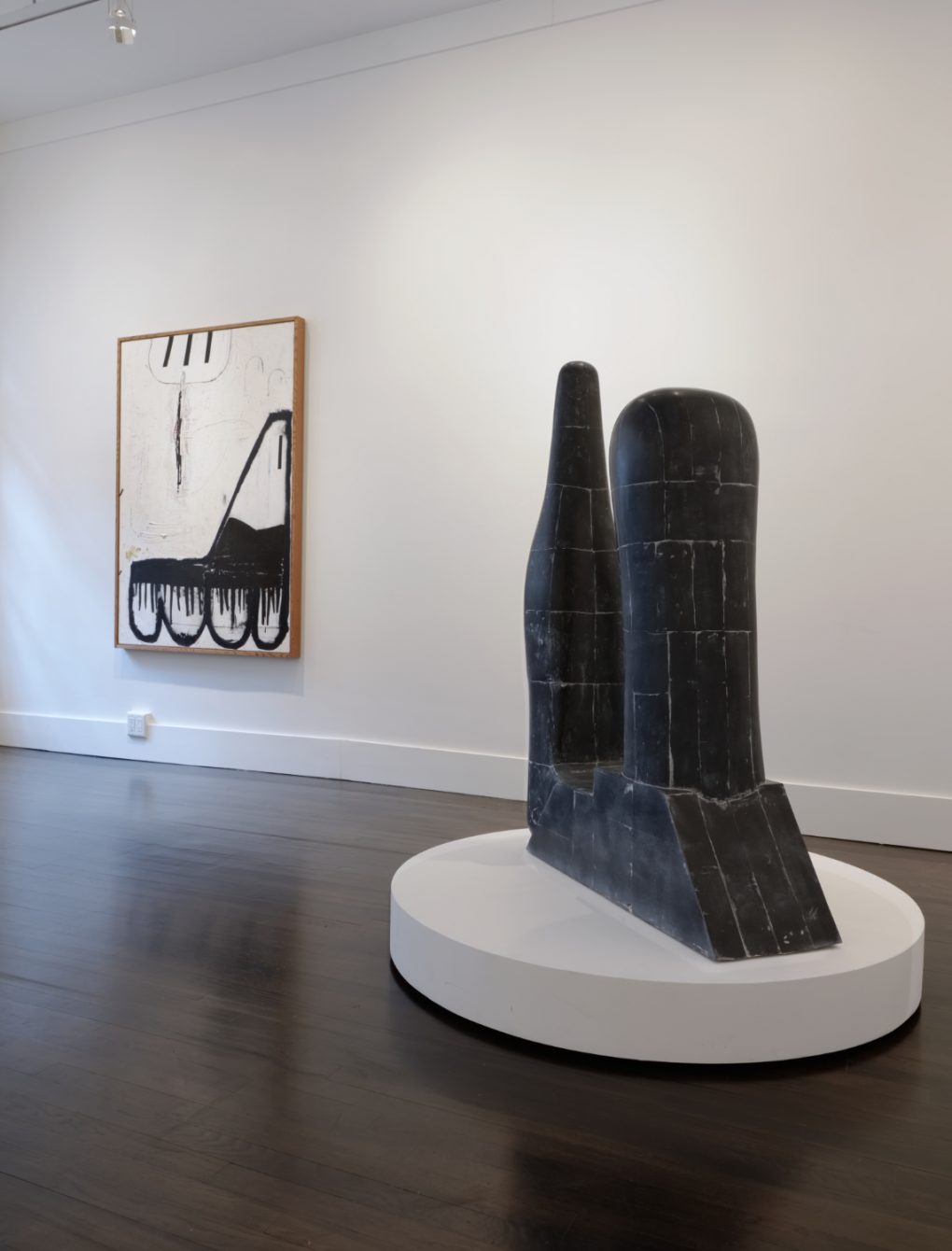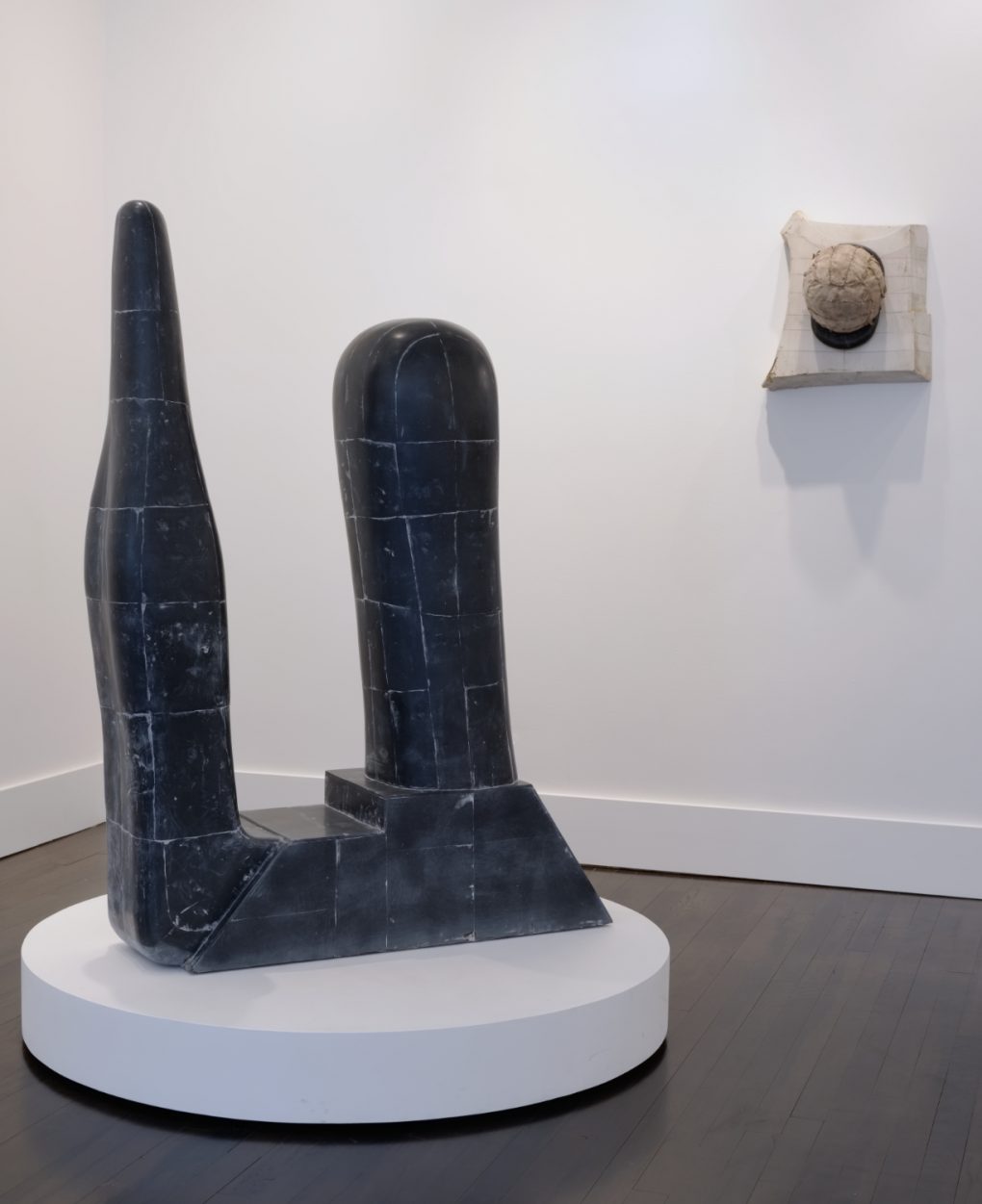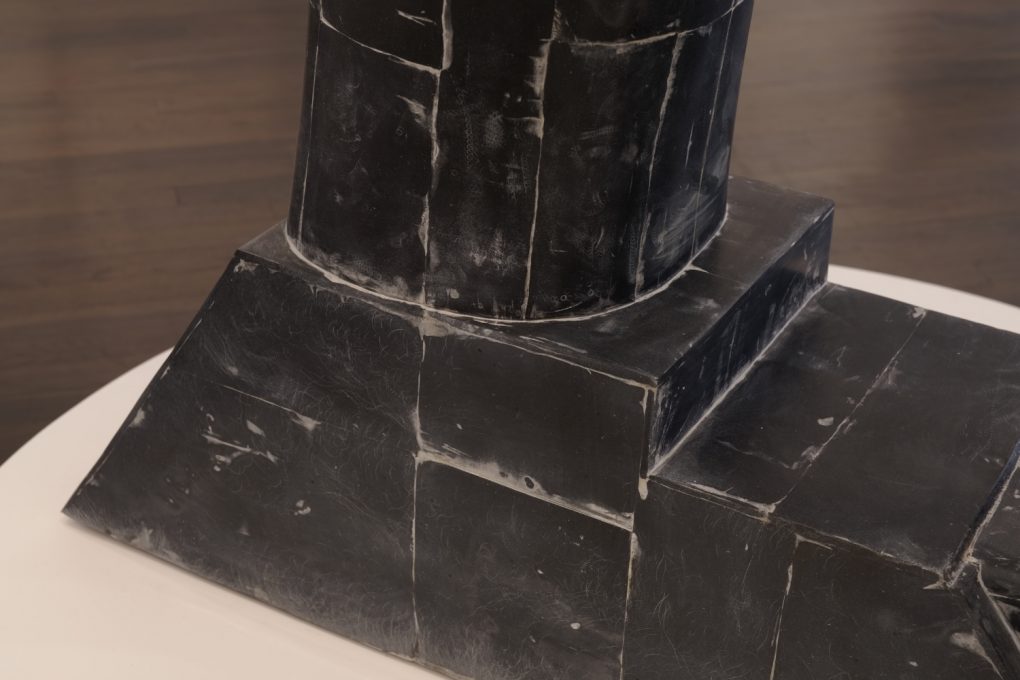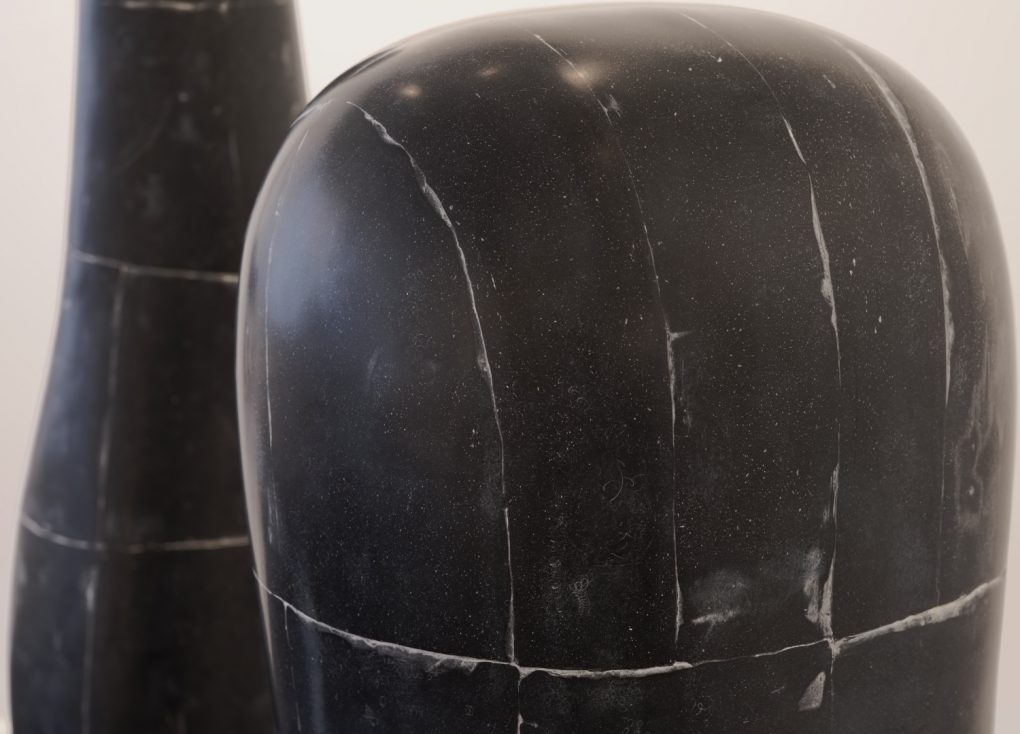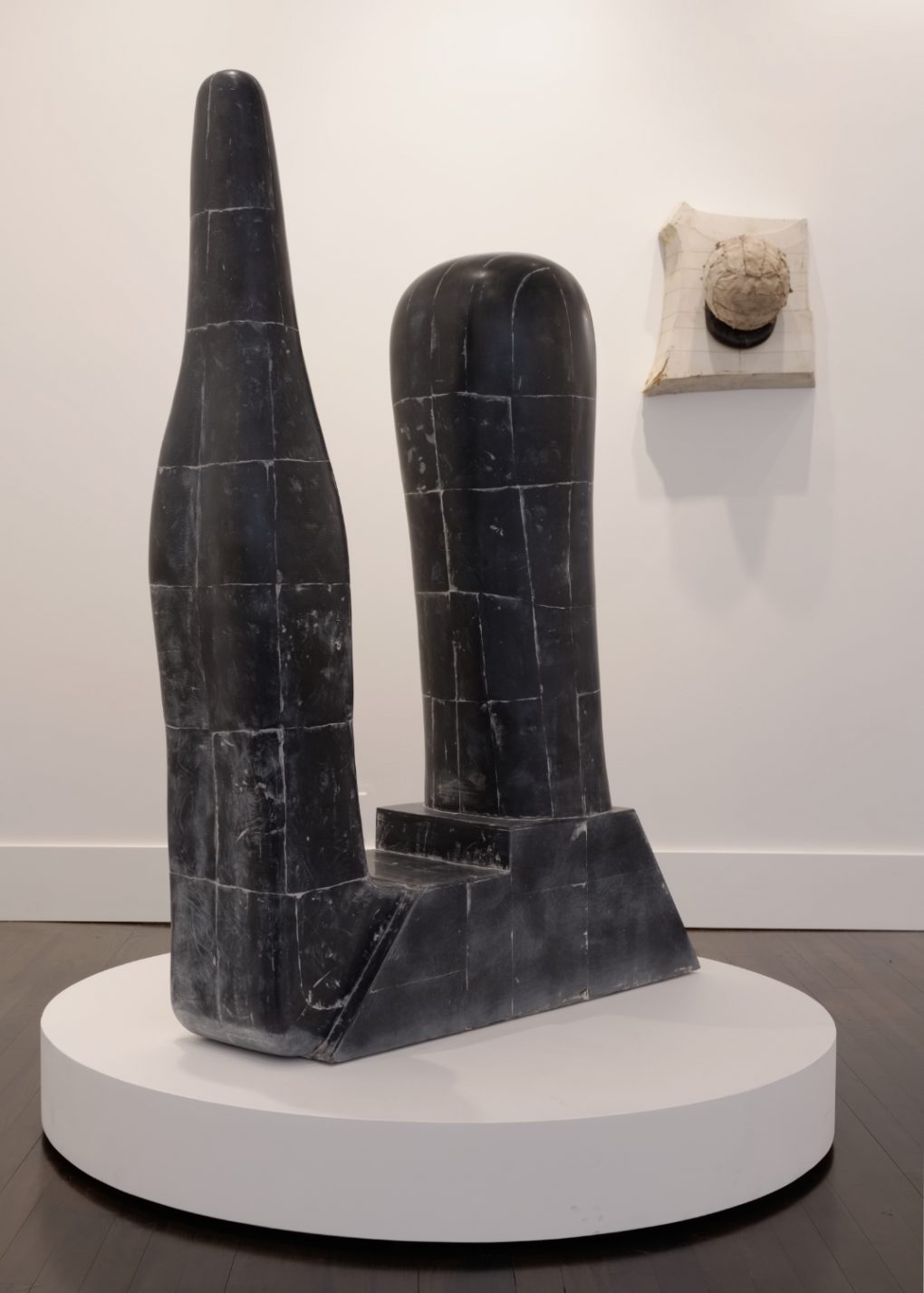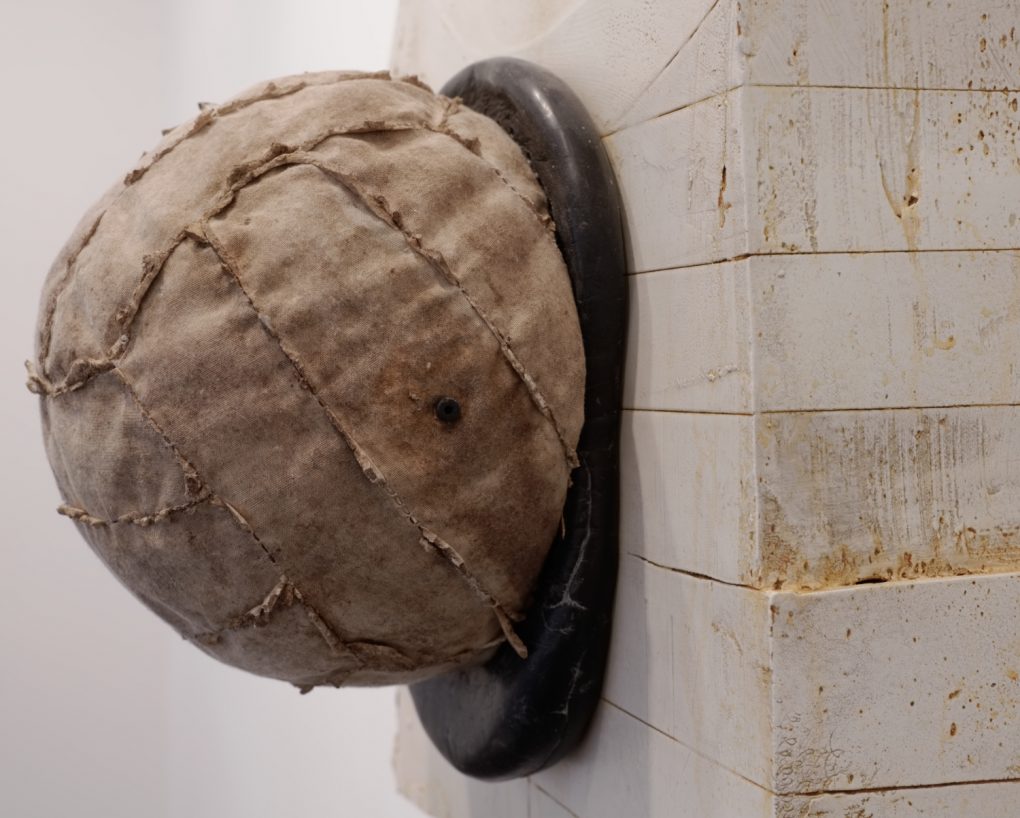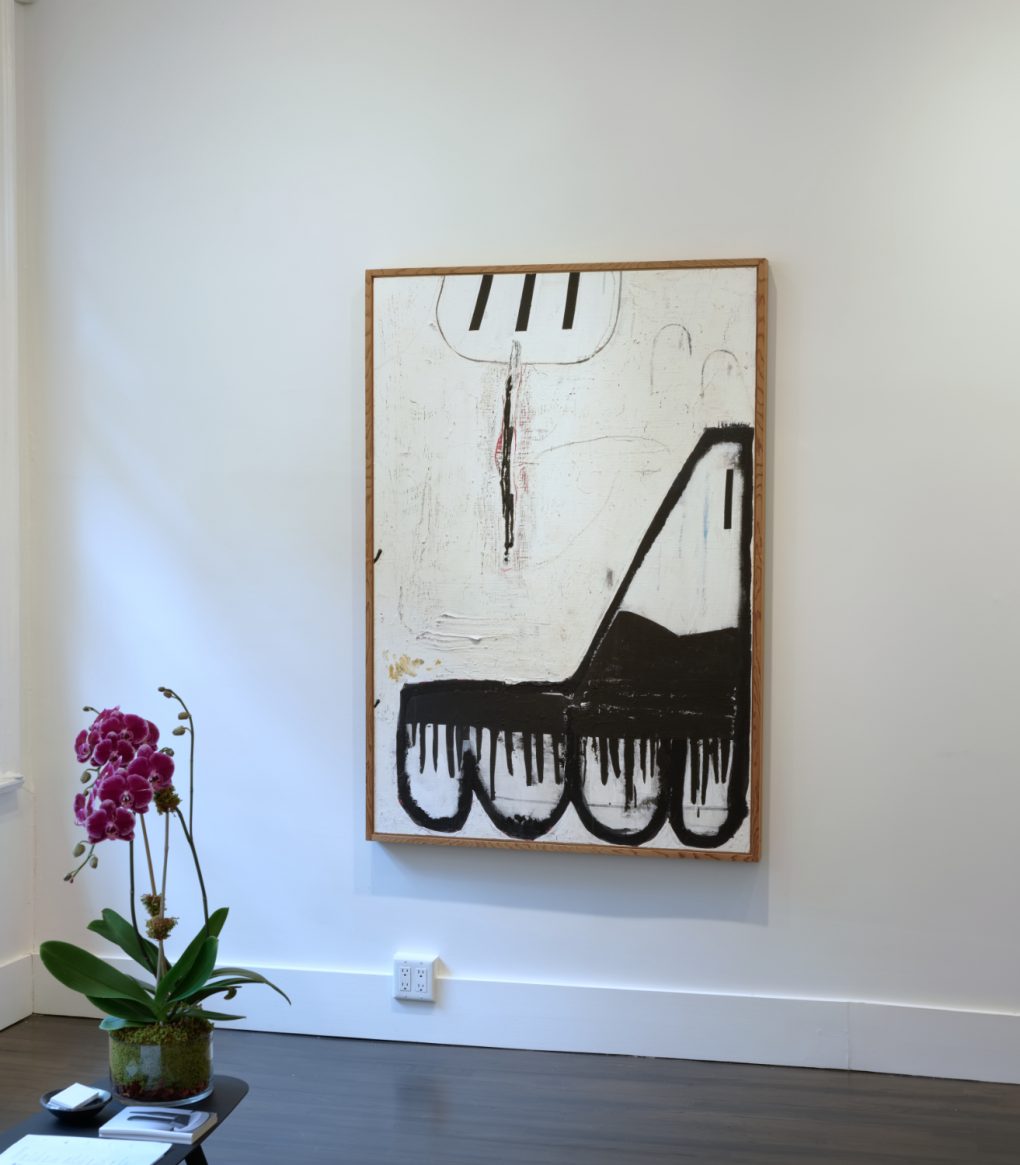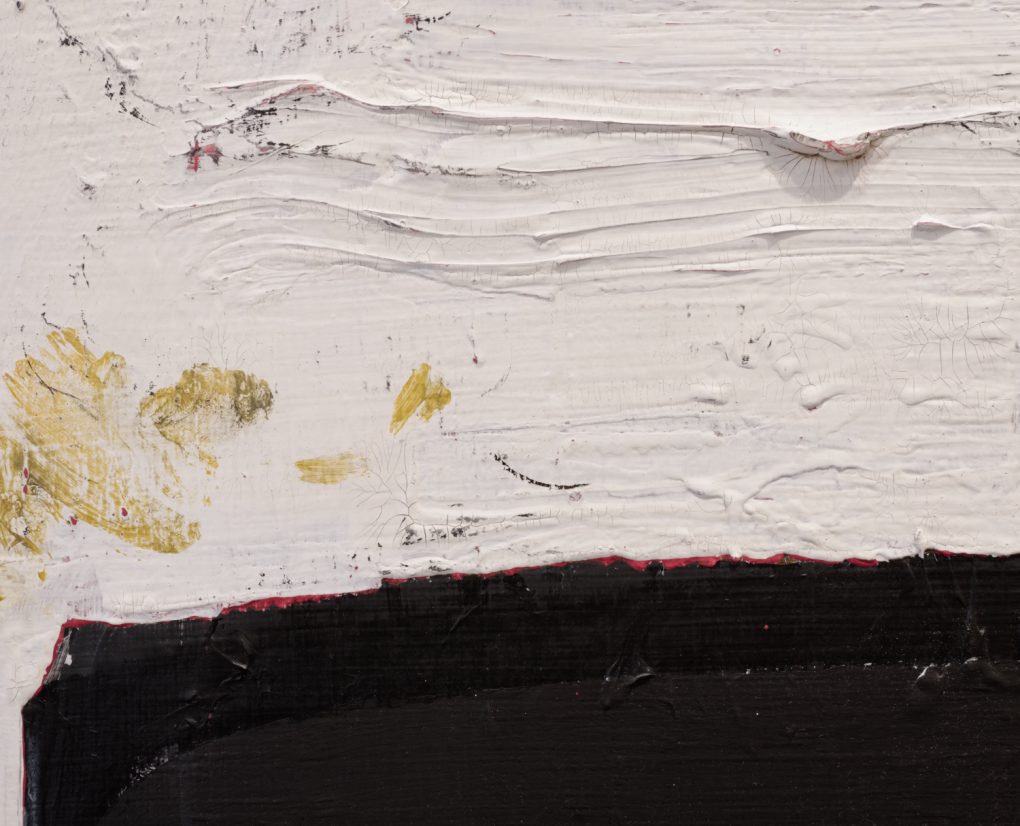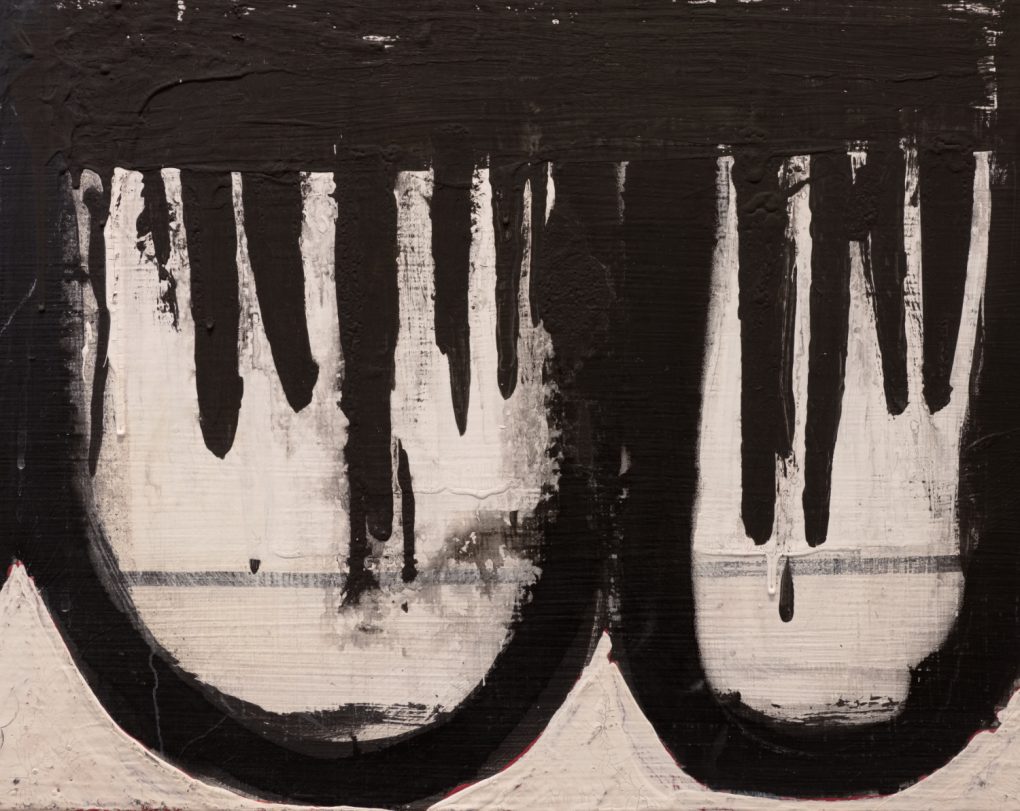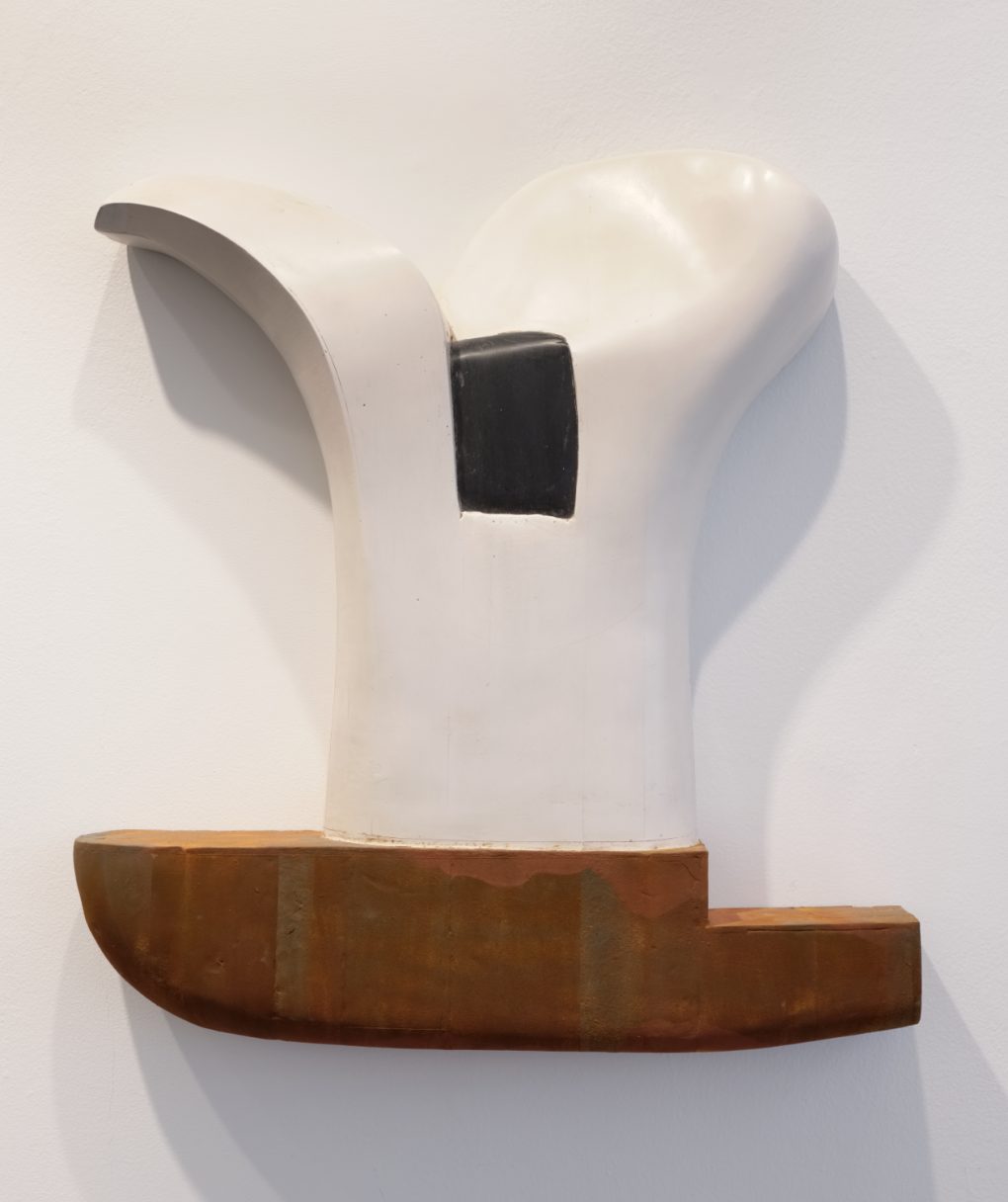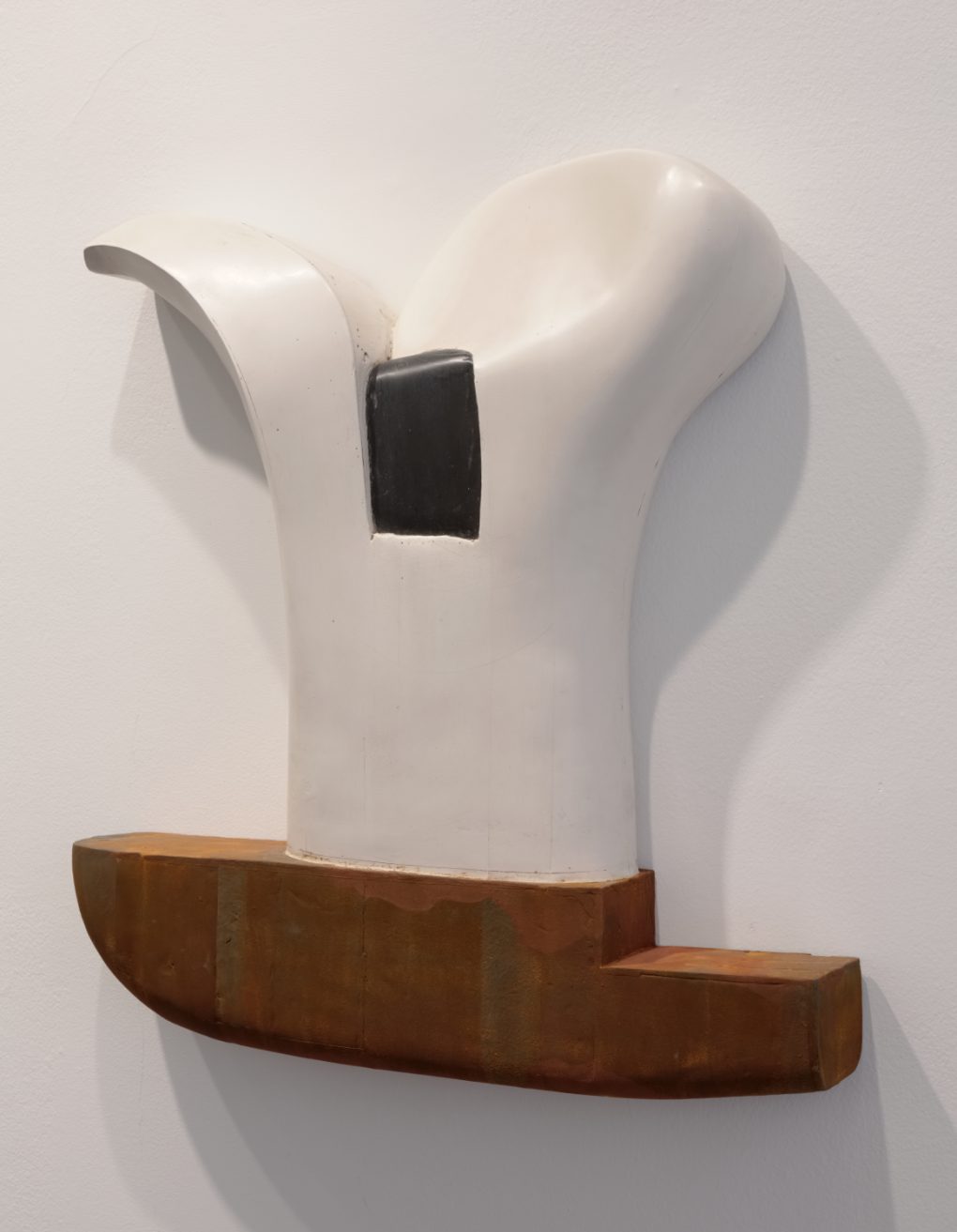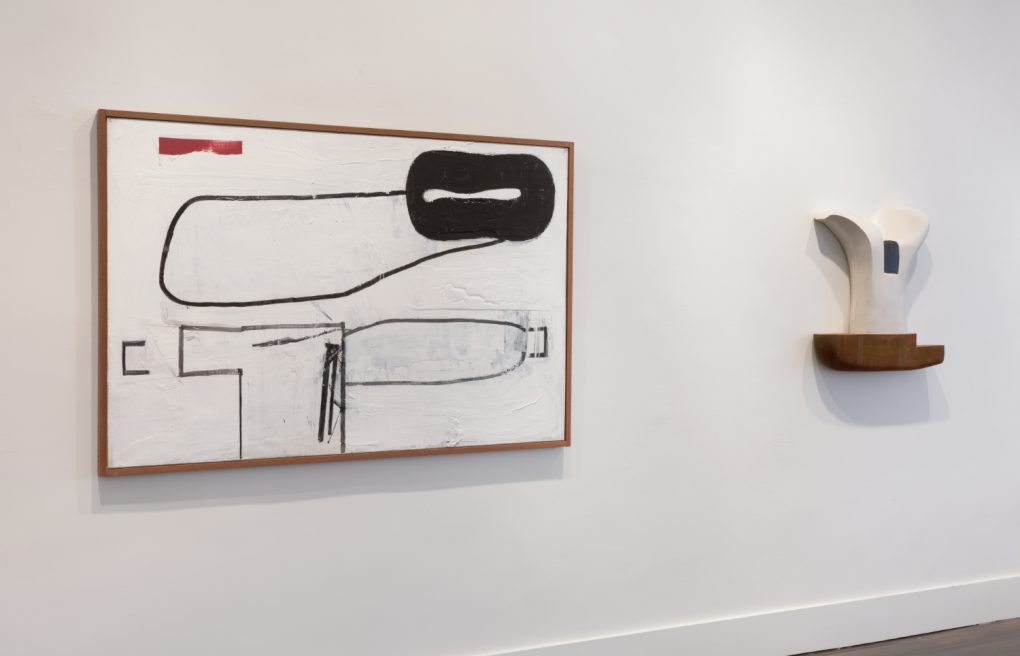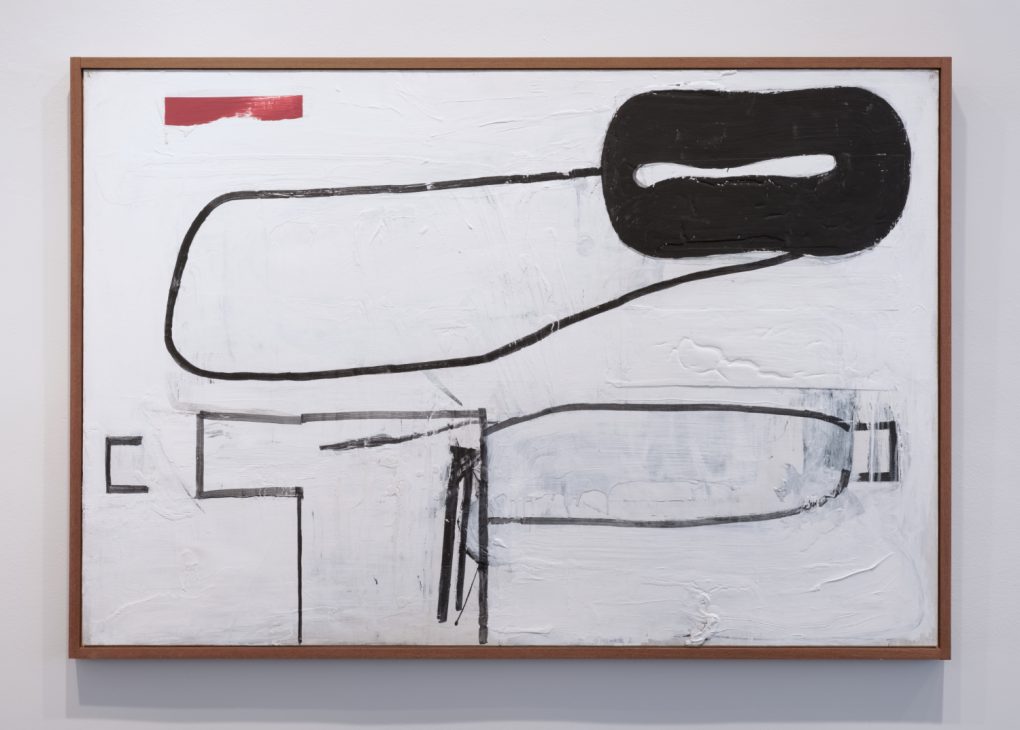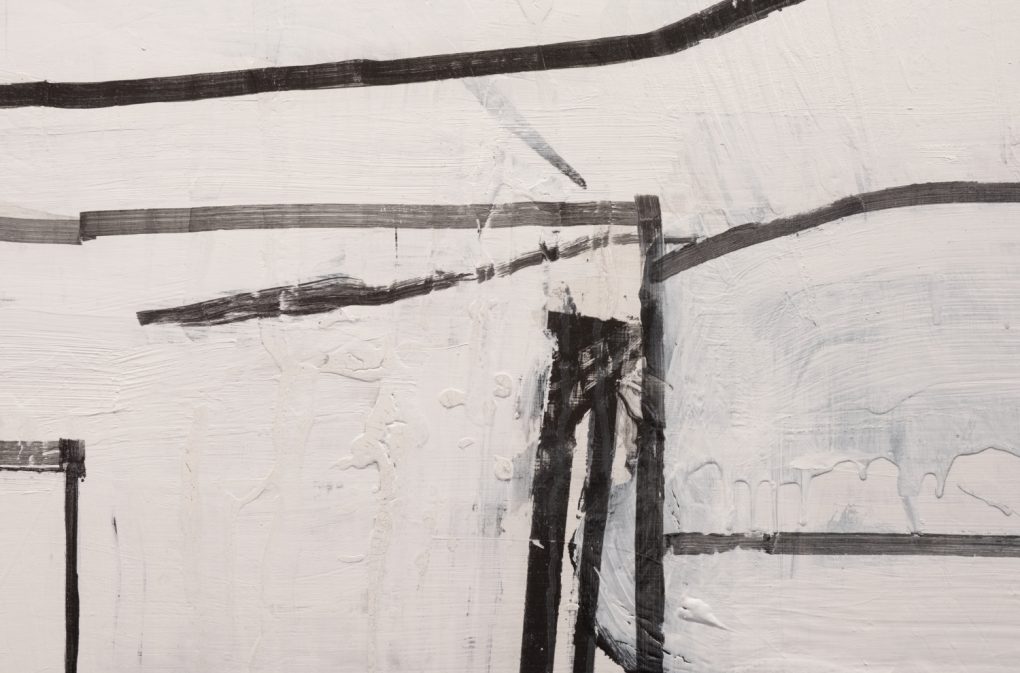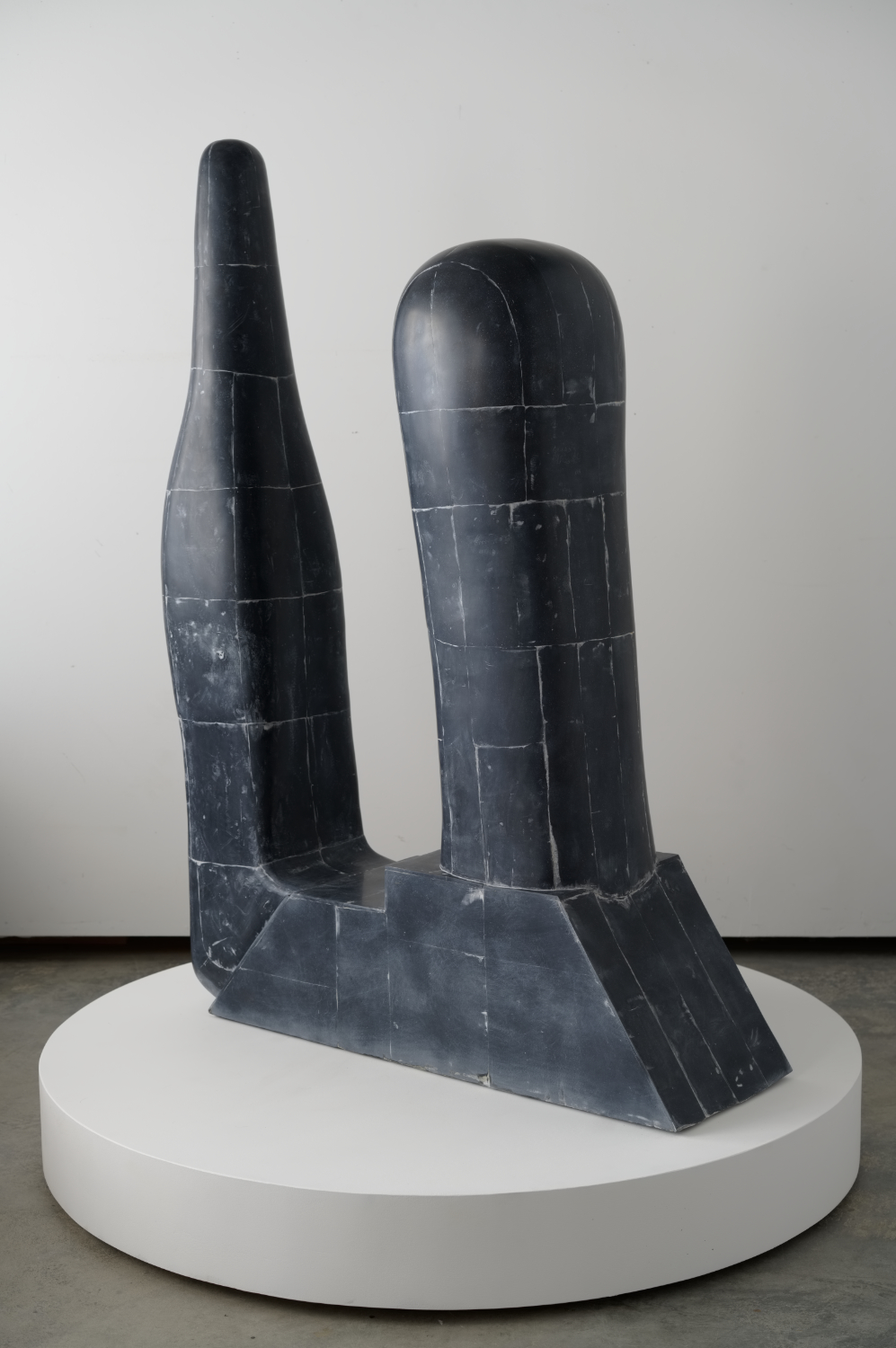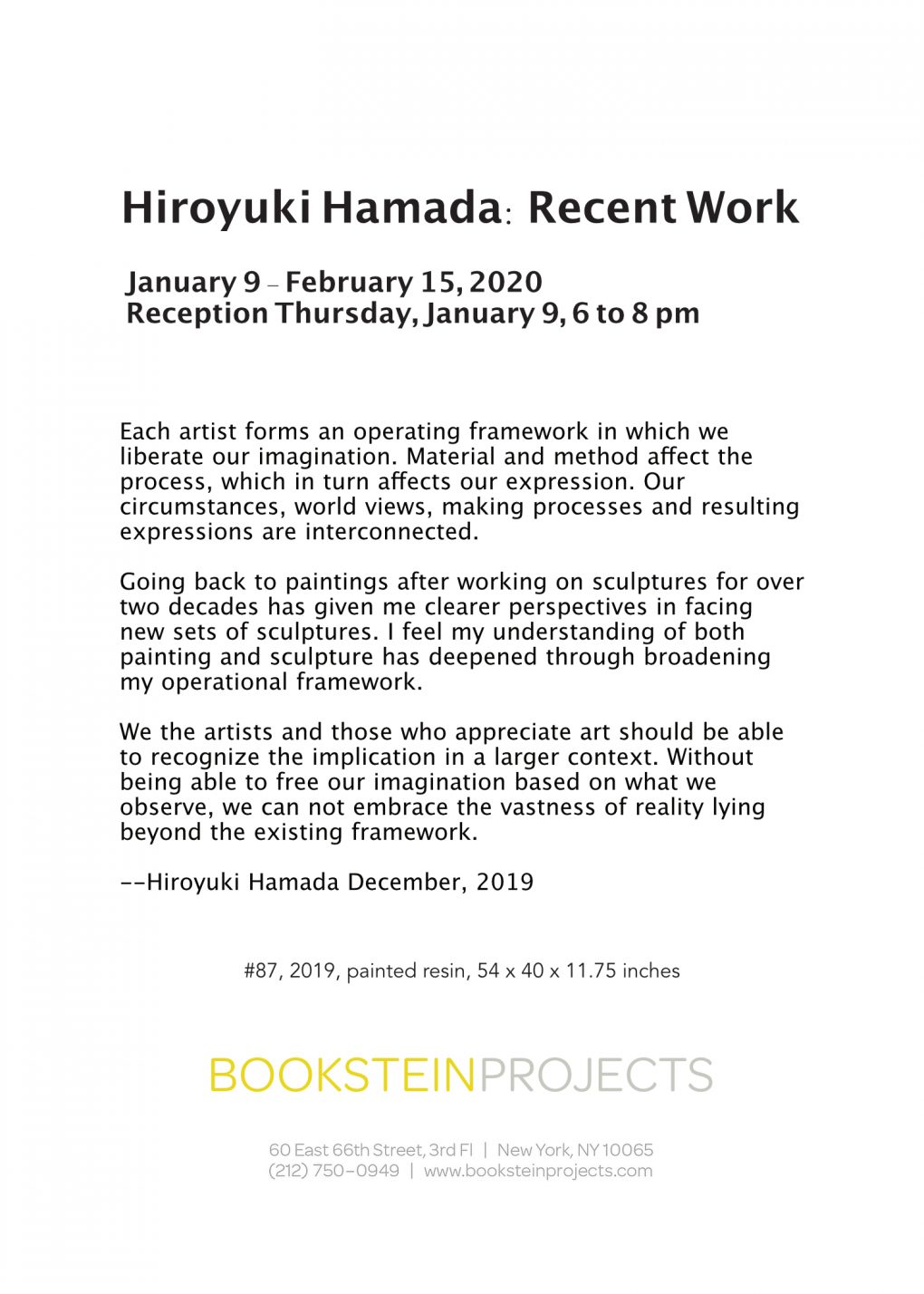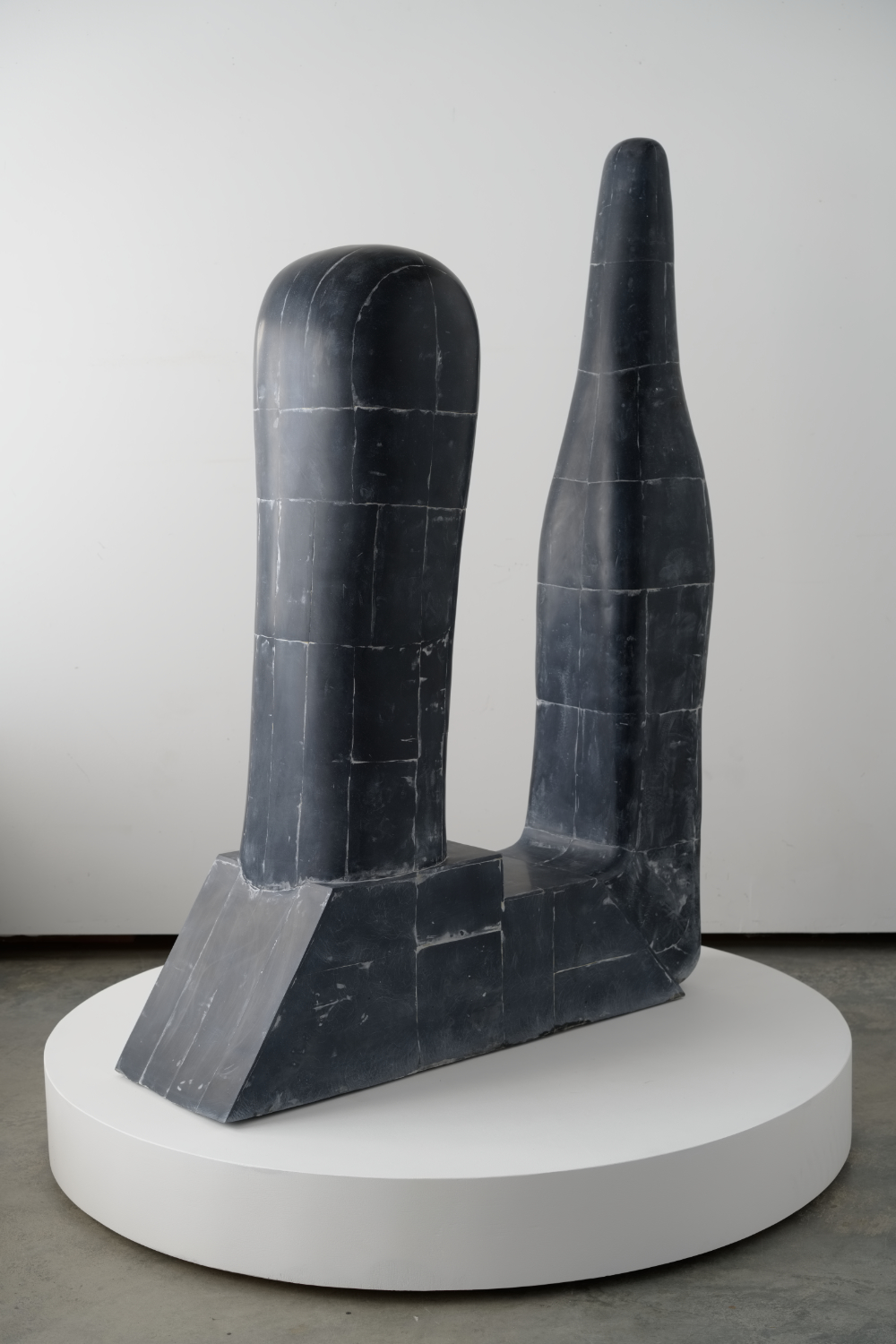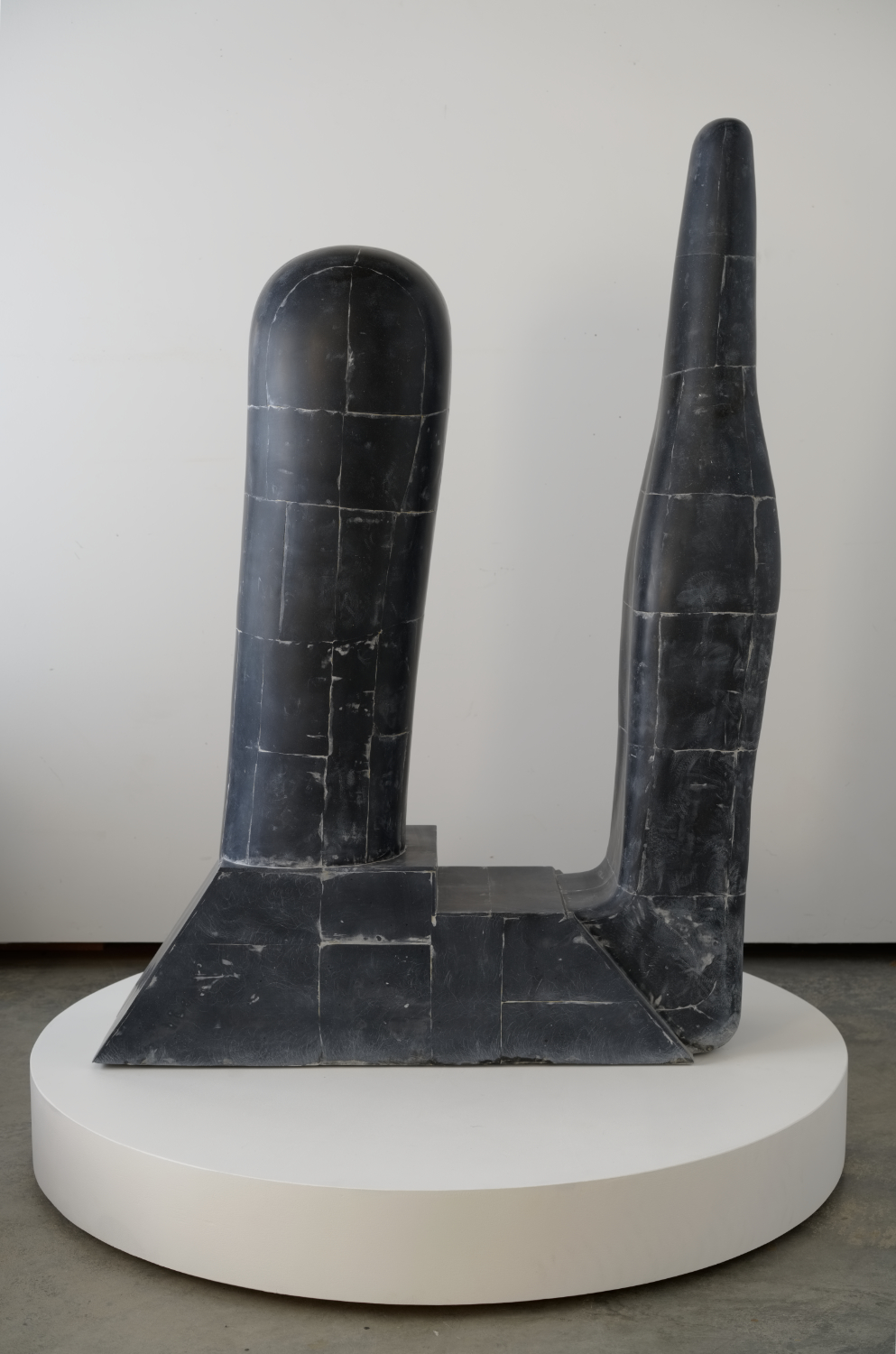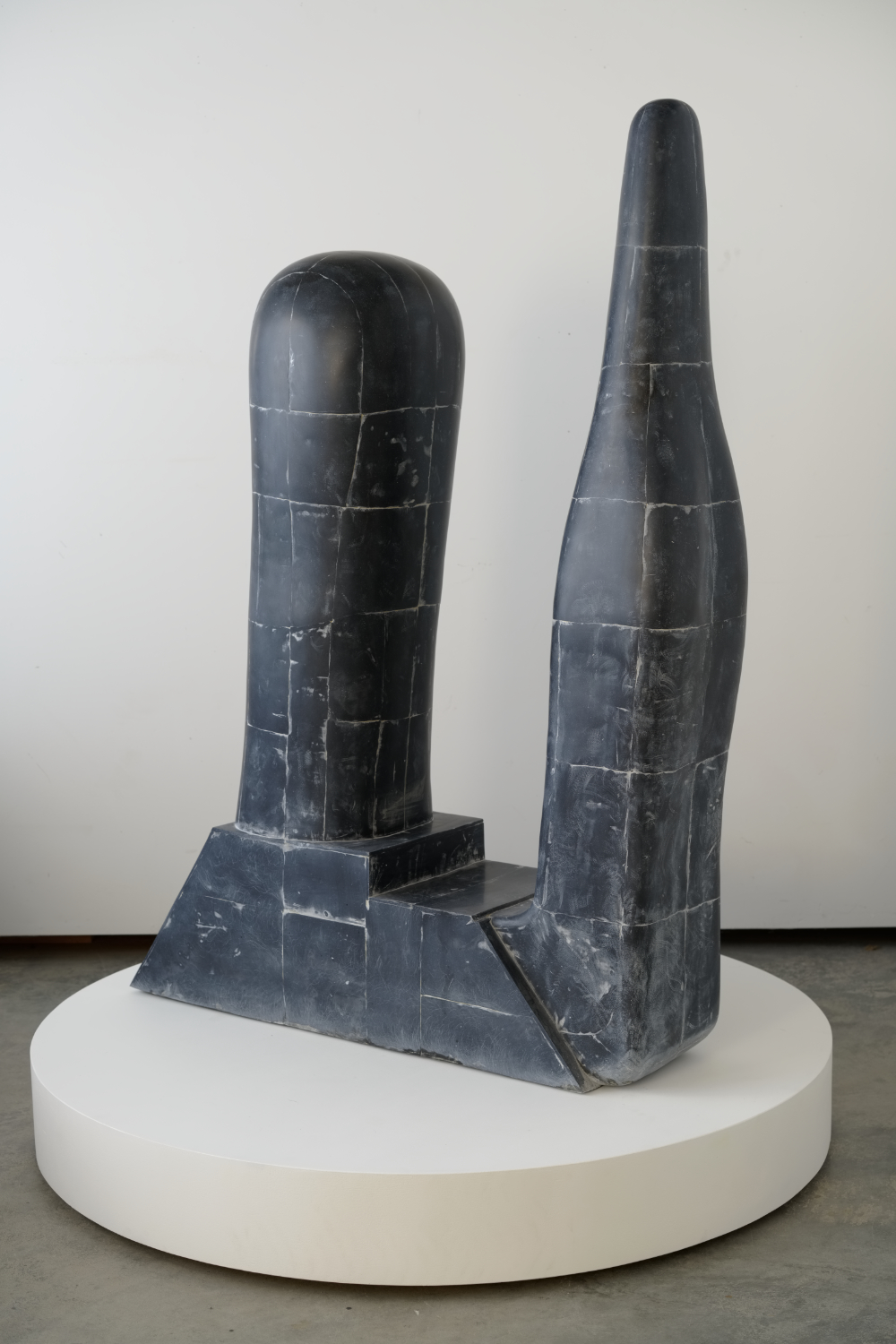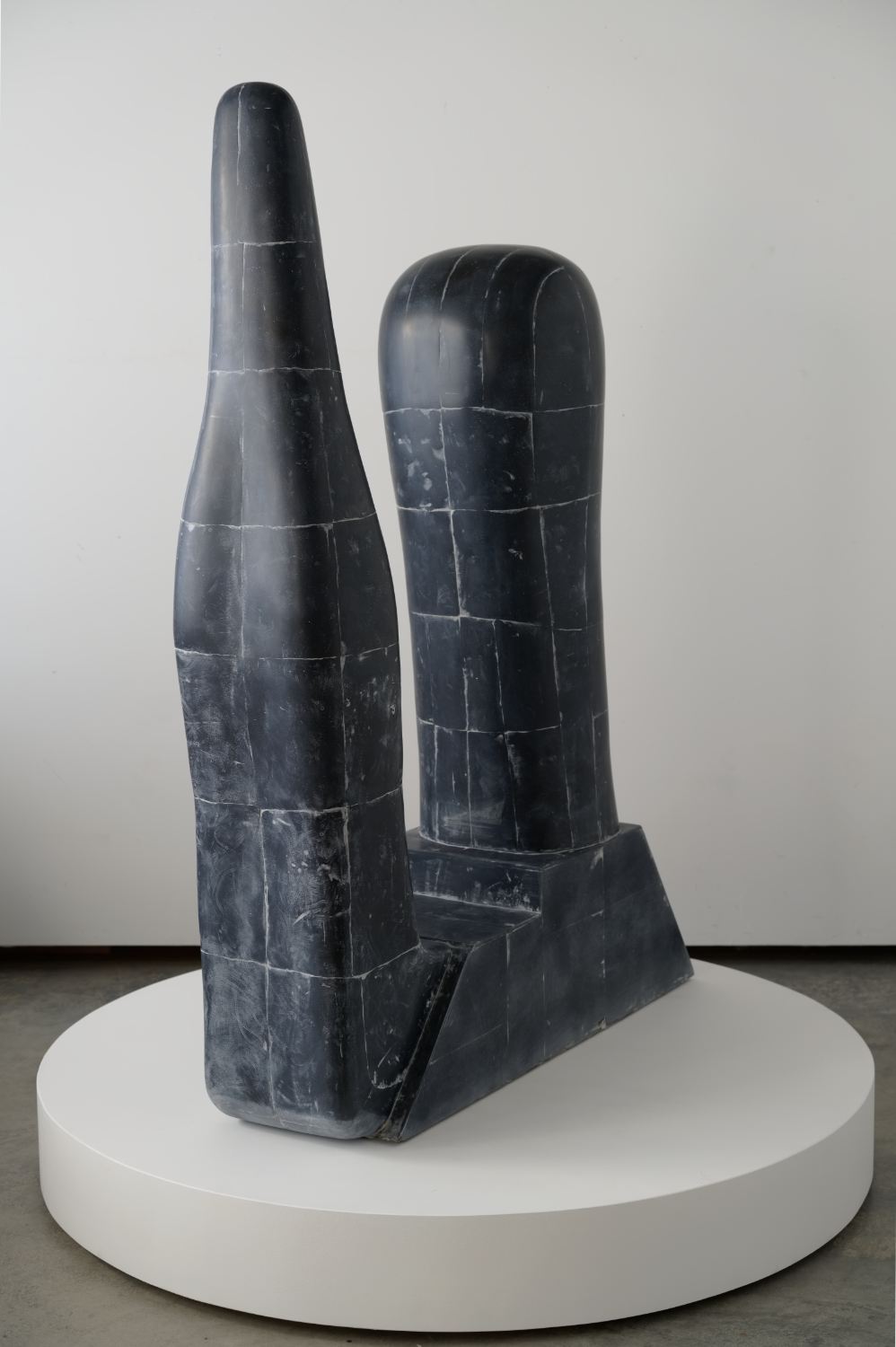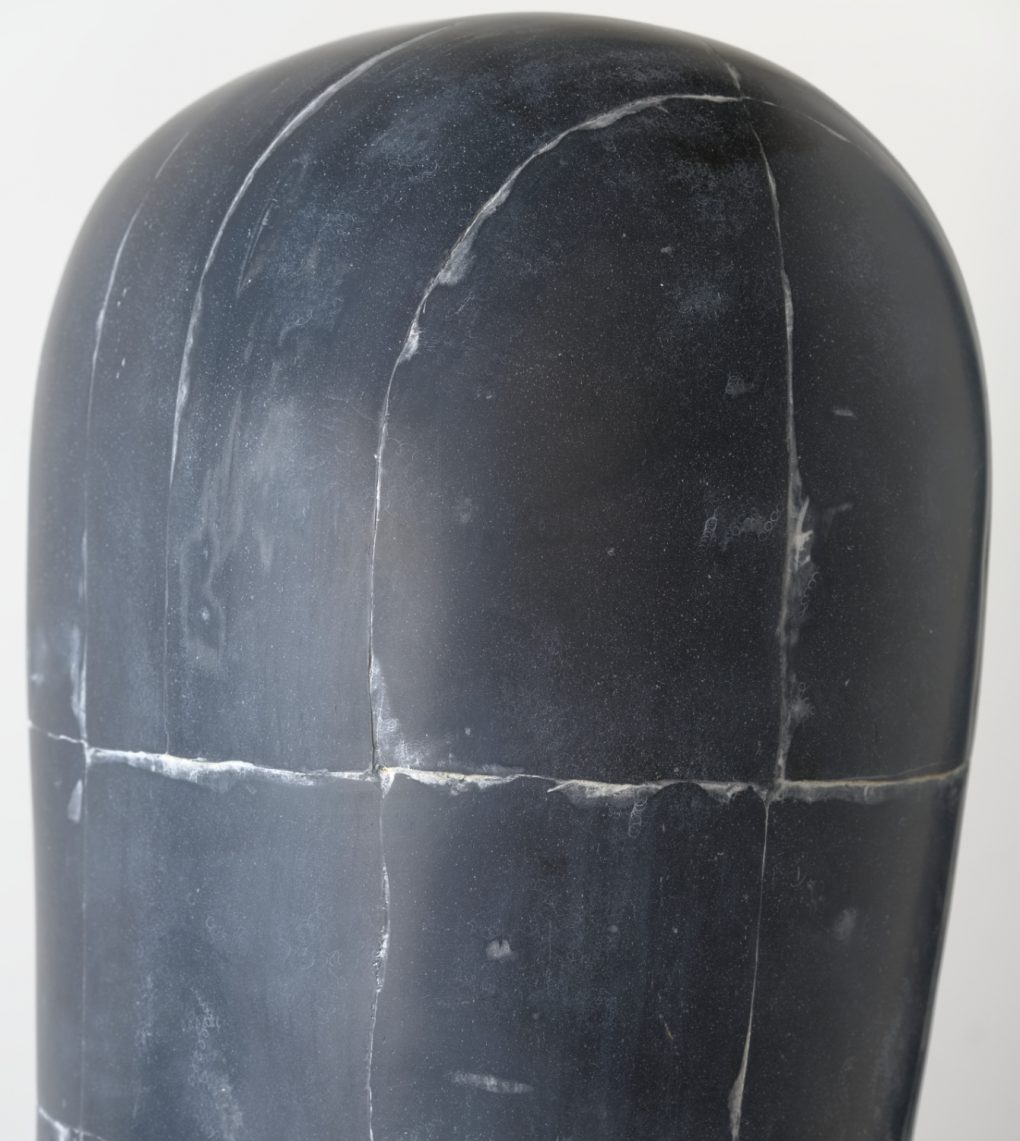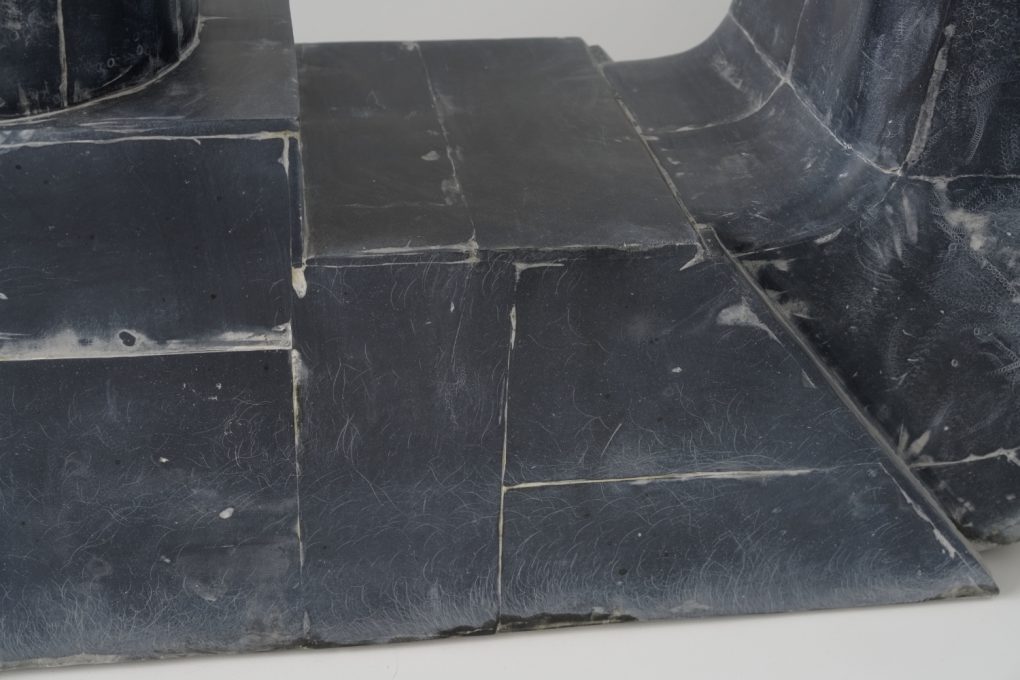-
Gana Art Bogwang Show 2022
I am not religious at all in a traditional sense. But being in my studio struggling to make work has taught me that there are incomprehensible mechanisms operating beyond our perceptions. The glimpses of the vastness show up as “uncanny coincidences”, “unexplainable perceptions”, “overwhelming emotions of unknown origins” and so on.
So when I felt an unexplainable familiarity in being in Korea, an overwhelming sense of nostalgia and extreme sadness in leaving the country, I was not too puzzled, but still the sensation was new and palpable. All I can say is that things connect in some unknown ways and I humbly feel it as it is.
This is one of the bigger shows I have had, with 17 art works in a large venue with 2 floors.
The pieces were selected by Jung Lee the director of Gana Art and his curators. The set certainly has a cohesive theme of some sort, but I couldn’t pin point it initially. The director basically said that he thought about the taste of the Korean audience. The pieces filled up the venue like they were made for it. They certainly made selections which are cogent and very effective as a whole.
Having been in Korea looking at its art, new and old, working with people there and breathing the air in Seoul, I came to speculate on an intuitive level that the theme has something to do with some sort of faceless force of nature which grips hearts of the people in the region. And grips hearts of people in surrounding regions just as the Japanese centuries ago were so passionately fascinated by their ceramics in a narrowly defined context of “wabi sabi” sensibility. In reality, though, what I am trying to describe exists in more fundamental and ubiquitous ways, which can manifest in countless ways. It’s the resigned harmony with the unknown vastness, which I also feel as a basis of my studio practice. To me, being in studio is to be a listener, a keen observer, a channeler, who reflects dynamics surrounding us as patterns which resonate with us with visceral significance.
And this somehow relates back to my feeling about being in Seoul—my familiarity and affinity toward it. I am deeply drawn to the land, food and its people without knowing exactly how or why. My attempt in articulating it seems to remain circular as words go around the essence.
In any case, I thank the wonderful people I met there and I look forward to our future collaborations.
Here are some images from the show. Some detail images have been added, which were photographed previously in my studio.
-
Conversation with Sean Sullivan
Here is an interview I have done with artist Sean Sullivan. Sean is one of the artists in the show Three Painters at Duck Creek, which I curated for the Arts Center at Duck Creek. I enjoyed our conversation tremendously and I thank Sean for being a part of the fantastic show.

Sean Sullivan’s paintings from Three Painters at Duck Creek. Here is a list of works at the Arts Center at Duck Creek site.Hiroyuki: How did you come to pursue visual art? Do you remember a special moment or a series of events that convinced you that this is something you want to do with your life?
Sean: I really came to art – drawing, writing poetry as a teenager right around the time I discovered music. Music opened my world up – gave me an awareness beyond my own experience. It’s always been and still is a very important part of the process for me.
As a teenager I was too shy to get up and sing songs so I channeled my energy into drawing and writing poetry. It felt like I was sending signals to unseen allies from behind enemy lines (still does). Drawing and writing poetry in a notebook felt possible to me somehow – both so close to the ‘self’ – idiosyncratic like handwriting. In other words, no one could tell me I was doing it wrong. Intelligence didn’t matter, training didn’t matter. I could pursue these ‘secret’ activities in earnest, at all times – even while in the classroom listening to the teacher or later on the job or traveling on a train, etc.
Coincidentally as I write this on Father’s Day – it was my father who really pushed me to pursue art and the creative life. He really believed in me and told me every chance he got.Hiroyuki: I like how you as a child recognized the essential quality of art to be an expression of who you are for those who can accept you as who you are. Ultimately, I think this is one of the fundamental aspects of art that validates its meaning in our society today. In fact, your work does resonate in me at some deeper levels.
I’ve learned that you have a special process that’s in between painting and print making. Could you describe how it works and what it does? And how you came across it and why?
Sean: I began using the oil transfer process about ten years ago. I came to it by accident – out of frustration really. Basically I apply oil stick to a sheet of newsprint and thin it out with a silkscreen squeegee until it resembles something like carbon paper. I then place the found paper face down on top of the oil transfer paper and make a drawing on the reverse of the found paper with a Bic ballpoint pen. Each color in a finished piece is represented by a different sheet of oil transfer paper – a hybrid sort of drawing/printmaking process.
Over the years the process has refined some and evolved conceptually as I began to think of this process akin to plate photography and musical recordings.
I use ‘found paper’ not out of some nostalgic yearning but because I find new paper to be kind of cold and homogenized. The history embedded (the marks and color) in found paper give me a head start somehow – something to react to. I source the found paper mostly from books (used bookstores and antique stores) that I either buy or many times friends pass along.
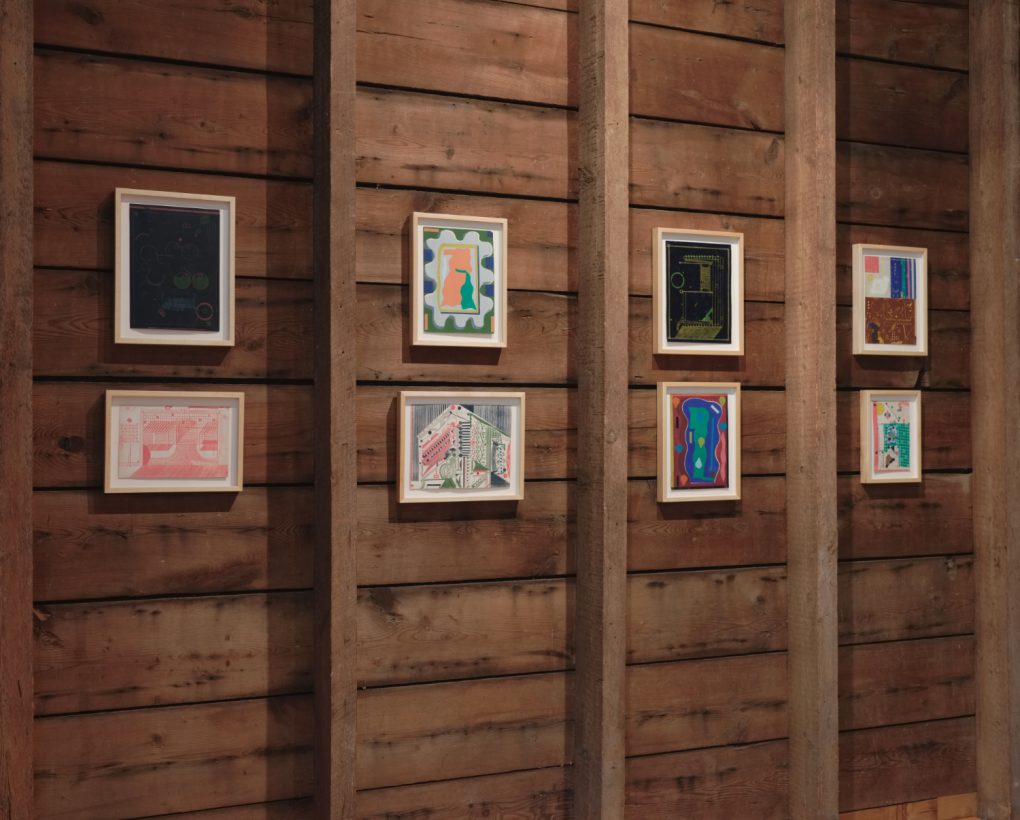
Sean Sullivan’s paintings from Three Painters at Duck Creek. Here is a list of works at the Arts Center at Duck Creek site.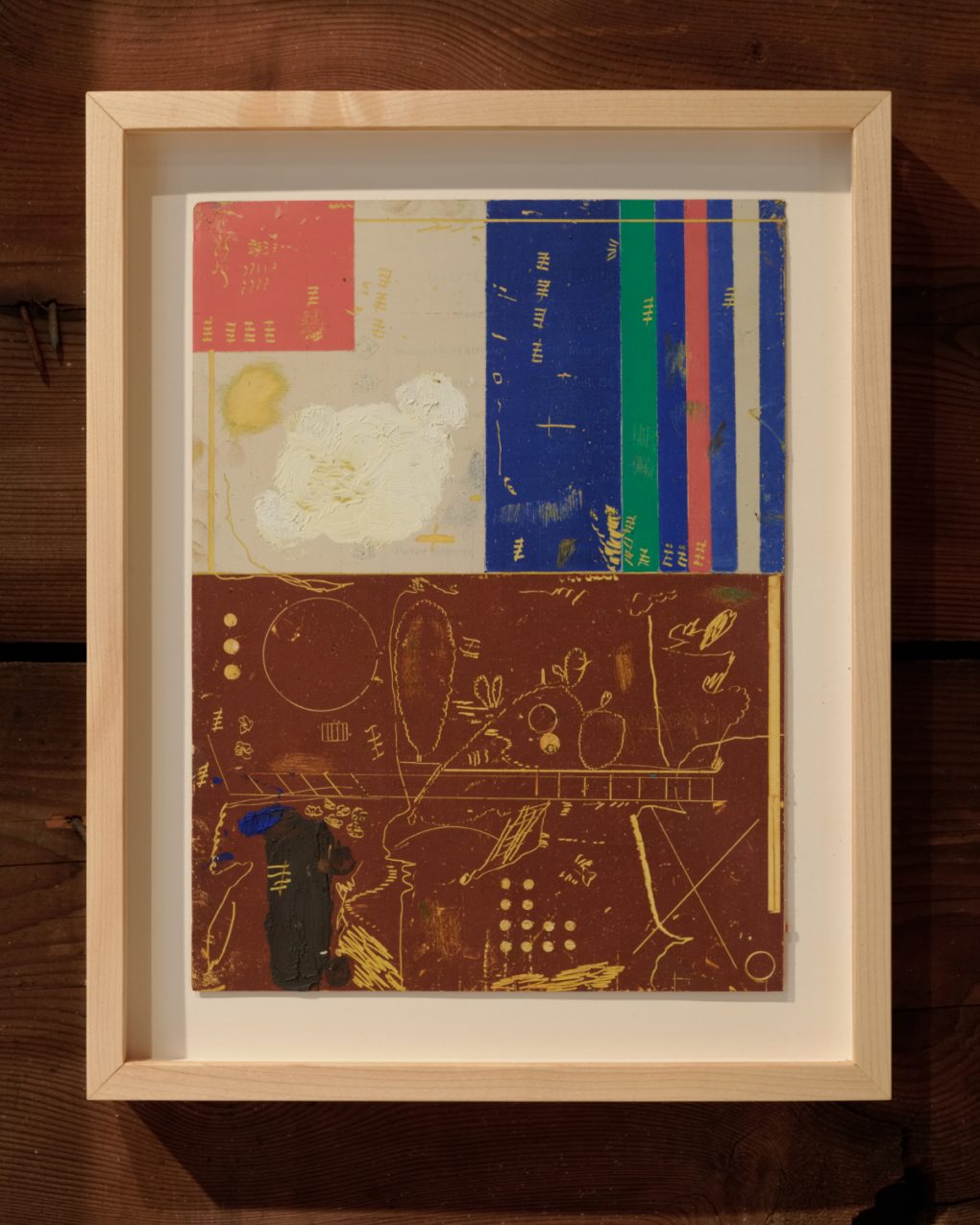 Carnival, 2020, Oil on found paper, Unframed: 7.75 x 10.5” / Framed: 10 x 14”
Carnival, 2020, Oil on found paper, Unframed: 7.75 x 10.5” / Framed: 10 x 14”Hiroyuki: So you have a real setting with its history and characters somehow when you start. And your action is an interaction with it as much as your own narrative coming out of your psyche. And perhaps the print aspect allows your process to manifest in unexpected, yet organic ways? And what about the imageries?
Sean: Yes exactly. The history embedded in the paper offers a starting point and the process allows for both predictability as well as improvisation. The imagery is improvisational – instinctual even if I try and start with a plan it always goes off track and I just go with it. A piece usually falls flat if I’m trying too hard to ‘do’ something – to control the outcome. Hope that makes sense.
Hiroyuki: It certainly does. How do you describe your improvisational process? Could you describe your work environment for the readers?
Sean: I think improvisation begins before you even sit down to work. It’s an exercise in faith or the practice of faith maybe? I don’t mean that in a religious sense per se, but faith in ability, in intention and in good outcomes. A trust that you can make something from nothing and even if there are ‘mistakes’ or setbacks, by adjusting expectations you can land in a more unexpected, inspired place. There is no right, there is no perfect and starting from that point – everything, every mark makes sense and has a place.
My studio is full of natural light and close to the family – a small sun porch attached to our living room. Marie and the kids are in and out all the time. It’s a perfect situation for me – I need them close by. The paint I use, R&F Pigment Sticks, I make for a living (for the past 13 years). It’s all close by I guess.
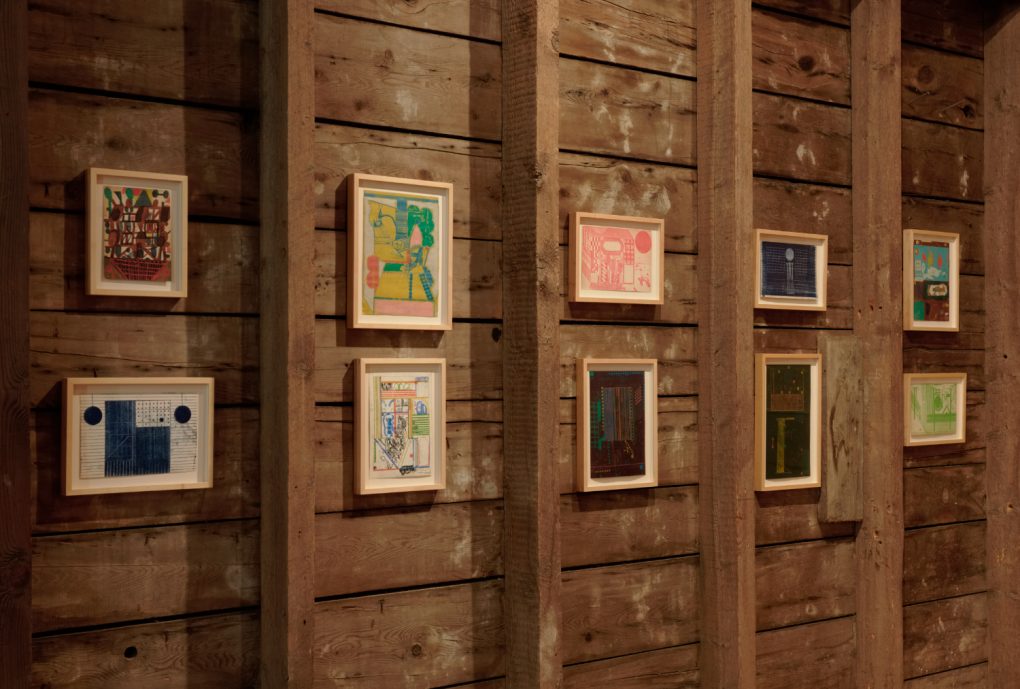
Sean Sullivan’s paintings from Three Painters at Duck Creek. Here is a list of works at the Arts Center at Duck Creek site.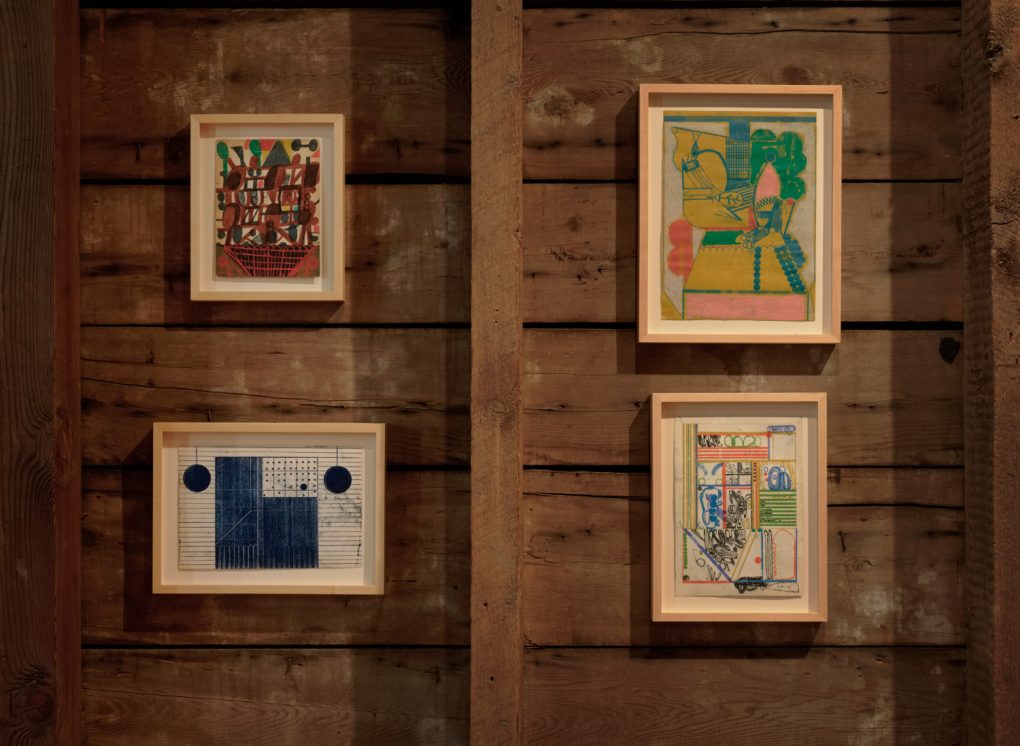
Sean Sullivan’s paintings from Three Painters at Duck Creek. Here is a list of works at the Arts Center at Duck Creek site.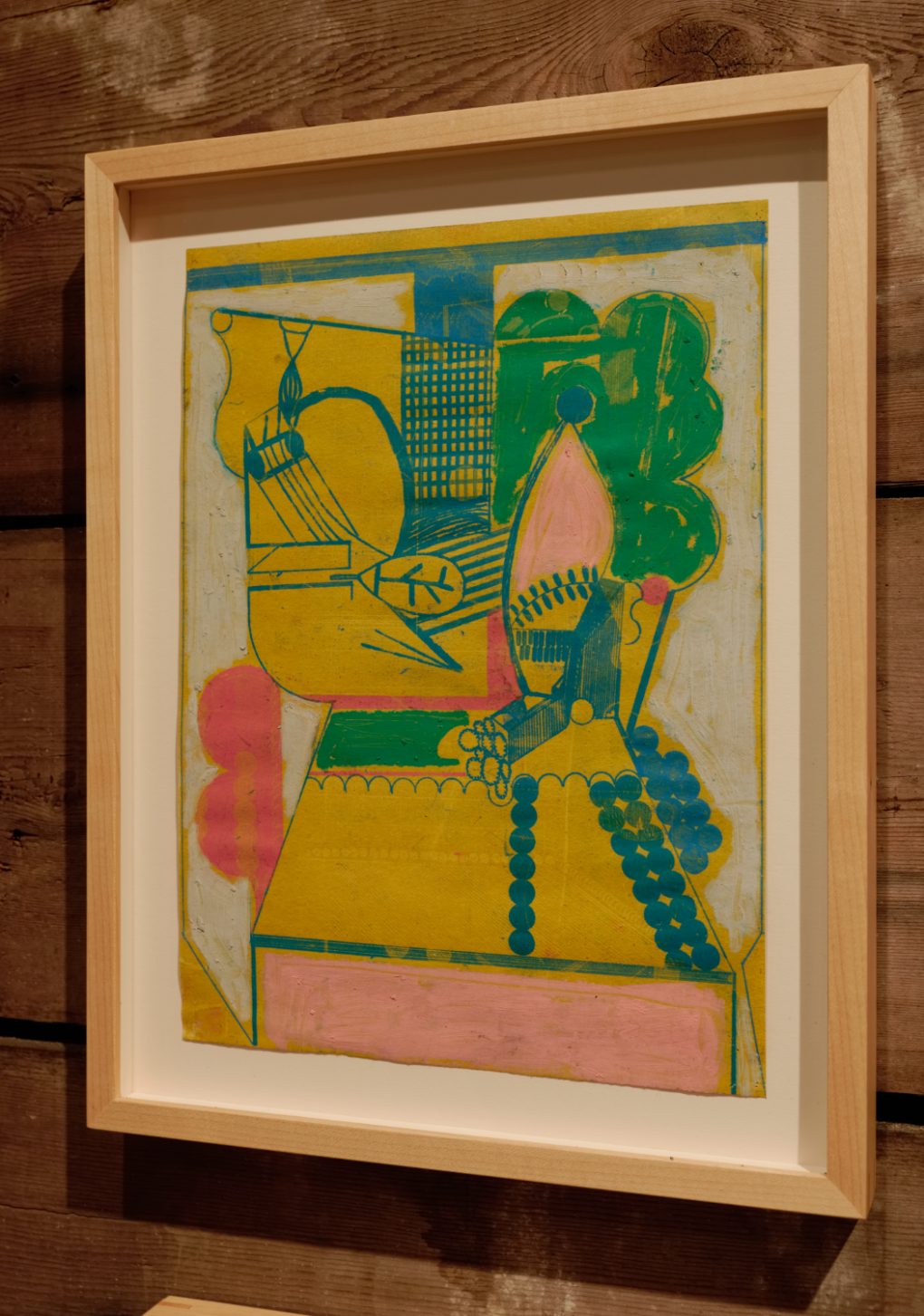 Rodriguez Solitaire, 2019, Oil on found paper, Unframed: 8.5 x 12” / Framed: 11.5 x 14.5”
Rodriguez Solitaire, 2019, Oil on found paper, Unframed: 8.5 x 12” / Framed: 11.5 x 14.5”Hiroyuki: I like that. There is an element of faith in facing the unknown as we make. When I visited you last time, it was eye-opening to see your work being so much a part of your family. This also extends to your position at R&F Pigment Sticks. Instead of seeing the creative process as an opposing element against your circumstance, you have put good efforts in creating an environment that enhances your work as much as your life and people you love. I think this is very significant in terms of making your “faith” grounded to your reality.
In your booklet “This Means I Always Have Something to Do. A Conversation Between Sean Sullivan & John Yau” you talked about differences between working within set conditions as opposed to being more flexible and organic. To me it seemed that you are good at putting your life in a cohesive framework so that you can be free within it.
Now, I assume that you must have challenges on your path. Could you describe some of the biggest obstacles and how you deal with them?
Sean: My apologies for taking so long to respond to this question – time is elusive! which brings me to a challenge I’ve always faced (I think many of us face) which is time – finding the time to make work. At this point I’ve come to terms with the limitations and to be honest if I had ‘all the time in the world’ I’m not so sure I’d be making better work or more work. Having said that I would like more time in the studio – even just for looking, moving things around – thinking. Another challenge I’d have to say is doubt – at times, extreme doubt – I think in some ways the other side of the coin so to speak. Normally I make work and don’t look back but every now and again I do turn and take stock and that can be sobering. I do have to say through all of these challenges I feel very, very lucky to make work and to share work and for all the talented, devoted individuals that I’ve had the opportunity to work with – galleries, artists, etc. and that I get to continue to make work and maintain balance in our family life is so important. I’m grateful.
 Fairgrounds, 2018, Oil on found paper, Unframed: 6 x 8” / Framed: 8.5 x 10.5”
Fairgrounds, 2018, Oil on found paper, Unframed: 6 x 8” / Framed: 8.5 x 10.5”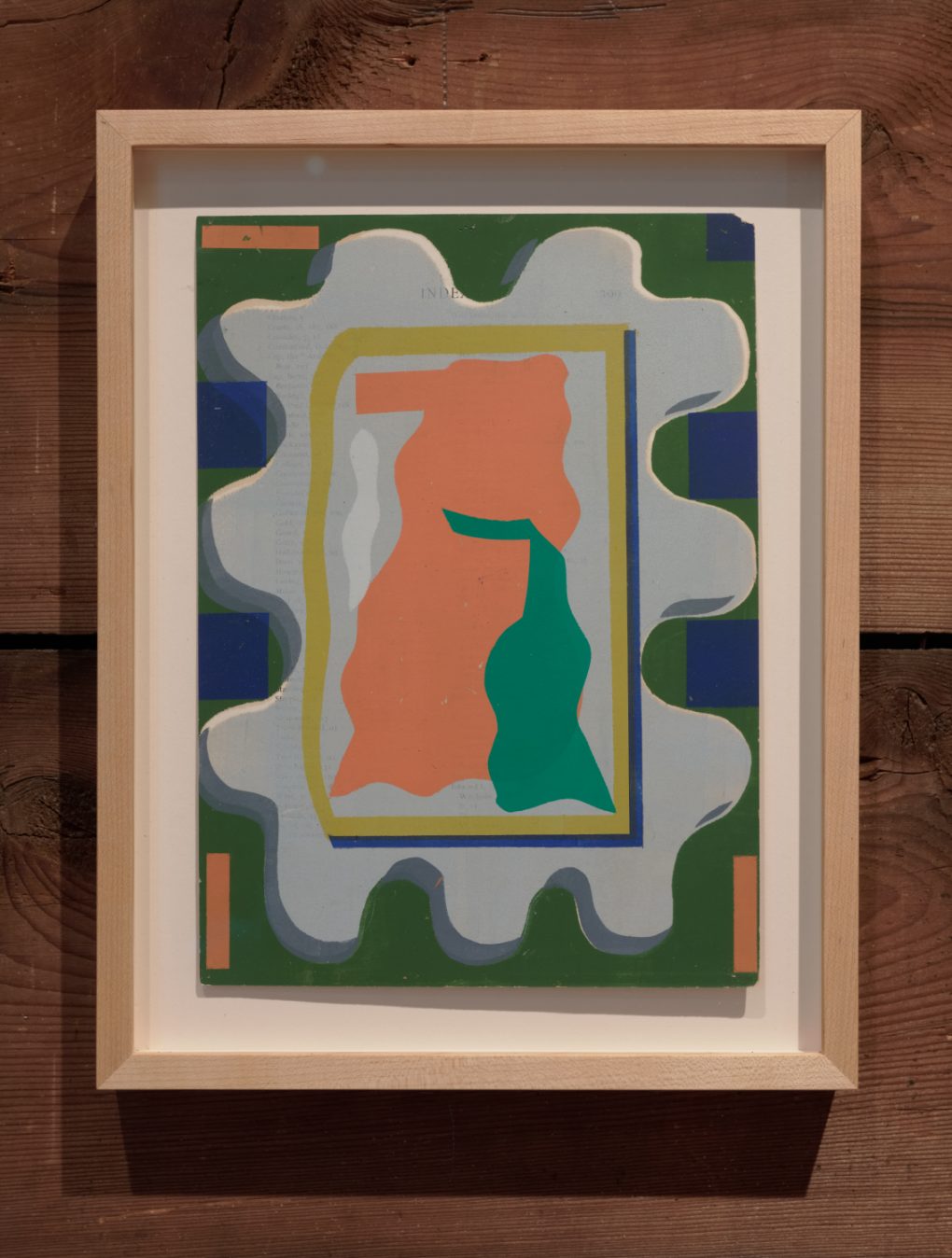 Things huddled together surrounded by uncertainty, 2019, Oil on found paper, Unframed: 7.5 x 11” / Framed: 10.5” x 13.75”
Things huddled together surrounded by uncertainty, 2019, Oil on found paper, Unframed: 7.5 x 11” / Framed: 10.5” x 13.75”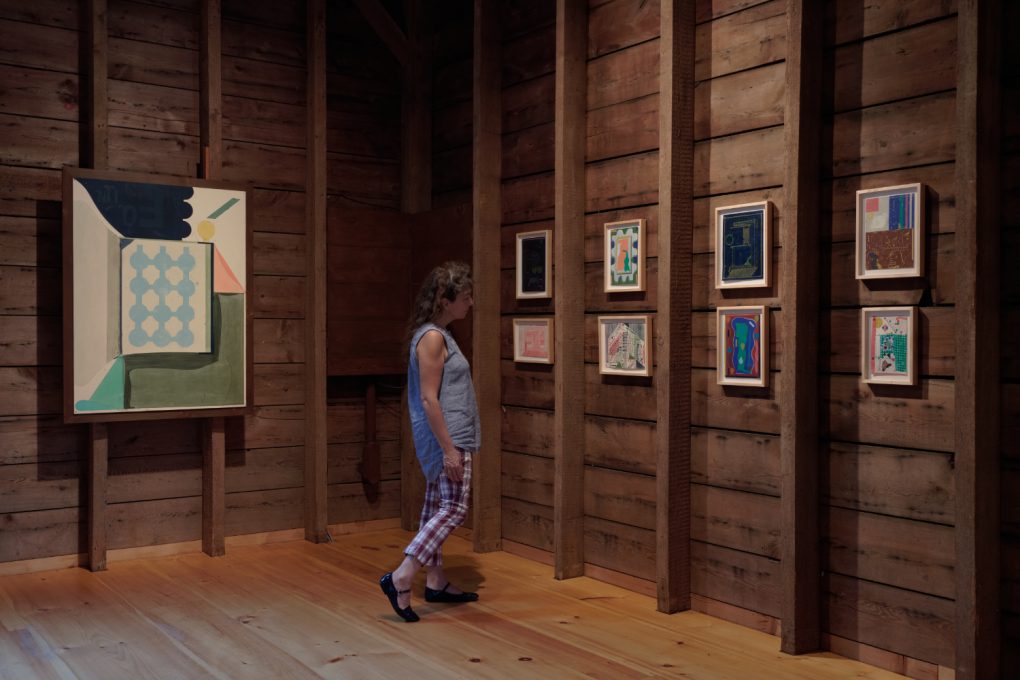
Sean Sullivan’s paintings from Three Painters at Duck Creek. Here is a list of works at the Arts Center at Duck Creek site.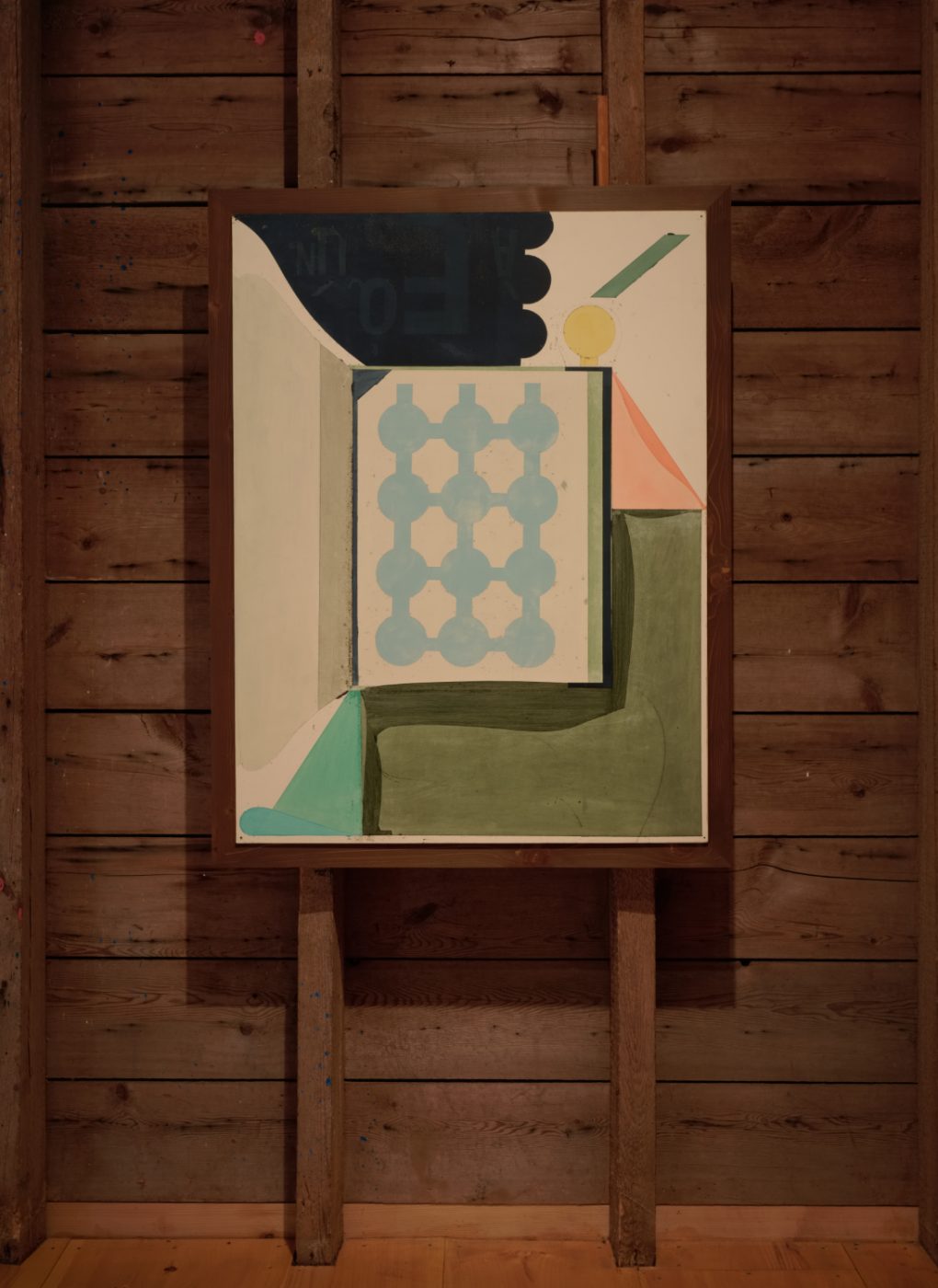 Futures, 2018, Oil on panel Unframed: 36 x 48″
Futures, 2018, Oil on panel Unframed: 36 x 48″Hiroyuki: You said “doubt–at times, extreme doubt”. Could you elaborate?
Sean: I think doubt in the studio, in life, extreme or otherwise, goes hand in hand with those moments of clarity and inspiration – grace. Time is really the salve. I think you just have to get through it, work through it, until there’s a ‘break in the clouds’. Maybe just the natural order of things – balance. Sometimes I think my doubt stems from not understanding where the work comes from so the ownership of it – the ego is thwarted a bit. If you didn’t ‘think of it’ then maybe you can’t entirely claim credit for it. Where does that leave you as an artist? An ‘originator’. But that is also what I love most about the process. The unknown – the mystery of it. This also works in reverse for me. What I mean by that is if I do have an idea, a ‘concept’ meaning the ego wants to direct the inspiration – it almost always (in my experience) leads to frustration and disappointment. I will say those excursions into frustration and disappointment are not fruitless and often lead to things unexpected – breakthroughs even.
Hiroyuki: Yes indeed, I feel what you are saying. Our perceptions seem to struggle at times, clouded by our immediate interests or lack of understanding, or often both. But, paradoxically, those obstacles also prompt us to explore and seek cohesive expressions that somehow resonate with us. In doing so we struggle to see and we face the unknown in an honest manner. This I regard as one of the most crucial aspects of the making process, which I believe resonates with our struggle in how to be.
Thank you so much for the fascinating conversation and I look forward to seeing more of your fantastic work.
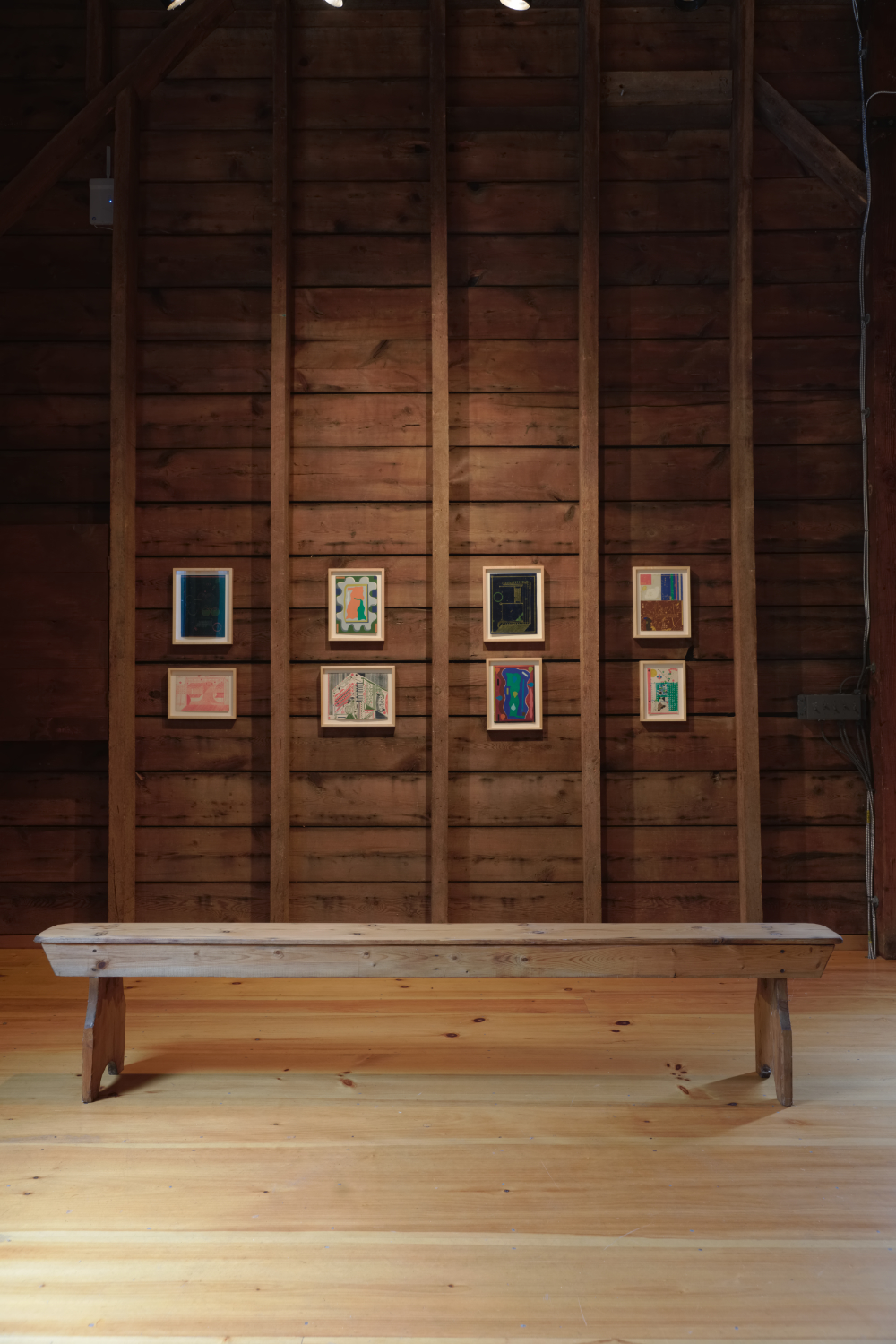
Sean Sullivan’s paintings from Three Painters at Duck Creek. Here is a list of works at the Arts Center at Duck Creek site.Sean Sullivan (b. 1975 Bronx, NY) lives and works in the Hudson Valley, NY. He received the NYSCA/NYFA Artist Fellow in Printmaking/Drawing/Book Arts Grant in 2017. Sullivan has participated in group exhibitions at the Samuel Dorsky Museum of Art at SUNY New Paltz, NY; the Markus Luttgen Gallery, Cologne, Germany; and the Museum for Drawing, Huningen, Belgium.
-
‘T’Space Rhinebeck Show
I am having a show at ‘T’Space in Rhinebeck, NY. It’s a beautiful venue surrounded by trees and the fresh air of Hudson, NY. The orchestration of the light and space in the compact venue creates a shrine-like serenity and harmony.
Lori and Joseph from Bookstein Projects have done an excellent job installing my work. The show will be presented at the ’T’Space website along with a poetry reading by Arthur Sze, and a musical performance by String Noise. I thank Susan Wides at ’T’Space for her hard work in putting everything together. We will also have a video production by Jack of Diamond LLC, which includes an interview between myself and Robert C Morgan. Notes on the making process with images from my studio are also presented. Read more about it at ‘T’Space site.
I’m excited and happy that our collaborative efforts have been going very well, and the show will be presented in an online livestream opening August 22, 2020 at 3PM. Register here.
Here are some images from the show.
-
Conversation with Elliott Green
Here is an interview I have done with artist Elliott Green. Elliott is one of the artists in the show Three Painters at Duck Creek, which I curated for the Arts Center at Duck Creek. I enjoyed our conversation tremendously and I thank Elliott for being a part of the fantastic show.

Paintings by Elliott Green from Three Painters at Duck CreekHiroyuki: What prompted you to pursue visual expression?
Elliott: In college I was majoring in literature, but a girlfriend of mine ran the slide projector for art history lectures, so I sat in on those classes, and in the dark lecture halls I was gratefully transfixed and transported through time and all over the world. It was a beautiful escape, and I started to draw in my notebooks, and finally dropped out of the University of Michigan in my third year to move to New York City to learn how to paint. When I landed there in the summer of 1981, I took a couple of month-long courses at the Art Students League, then painted on my own ever after.
Hiroyuki: So, you felt it was a “beautiful escape” when you saw the images in the art history classes. Were you conscious about what you were escaping from? Did the momentum to quit school and move to NYC have anything to do with it, or were you simply under the spell of what art could do for you?
Elliott: That’s a very good question! I was bored and frustrated: mostly with myself, the Midwest where I grew up, and my waning interest in writing fiction. I felt I was in a holding pen — and I had ambitions to do something good and tangible — to test and prove my Self in the larger world; but I didn’t know how that was going to take shape. I was inexperienced. I was immature and impatient. But it turns out that I did find my life’s work after all — in making paintings.
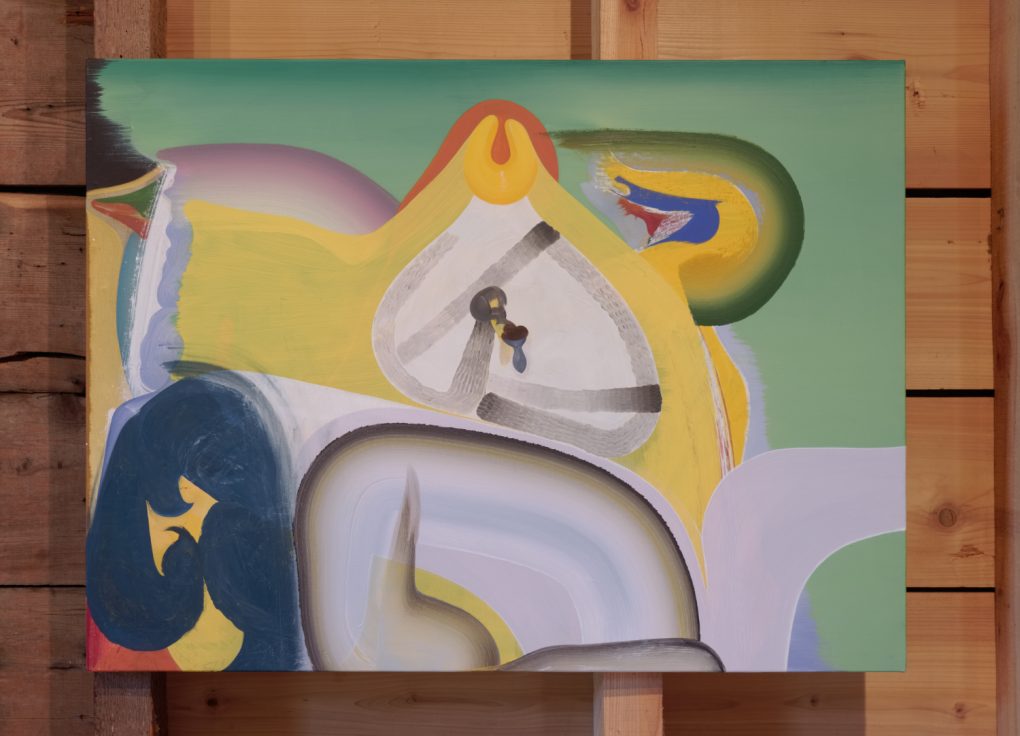
Dressmaker, 2011, Oil on linen, 43 x 40″Hiroyuki: It sounds like you had something in you that needed to come out. Naturally, I think of the explosive energy, poised serenity, and exquisite dynamism of your current work. The colors, movements and rhythms are just bursting out of the canvases. I’ve read that the current direction emerged after your trip to Rome as well as your move to Athens, New York. What do you think has allowed you to be expressive in this way? It seems that your interests in visual elements themselves has been liberated, as opposed to your former expression through recognizable figures, the narratives and more limited usage of visual elements.
Elliott: Actually, catharsis has been a leitmotif in my work, and that was probably something I gleaned from studying literature and film. Often in my paintings — from out of some placid zone of quiet painting–a loud gestural eruption occurs. It’s dramatic, and it’s something I can do by heightening or lowering my physical — my muscular and emotional energy, like a musician or an actor. Another narrative that occurs a lot is to have a constricted space that blasts open into a vaster one. A remarkable thing happened in Rome: the density and compression of the two-dimensional abstract paintings I had been making for several years expanded outward when that information was transposed into the landscape format, into perspective: that was like an explosion. The additional space gave the previously contained subject matter freedom to move from the distance to the forefront, and it was like an infusion of fresh air. It was liberating. And the shapes, like the round or sharp ones of the mountains, took on characteristics–recognizable personalities–like the figures I had painted years before.
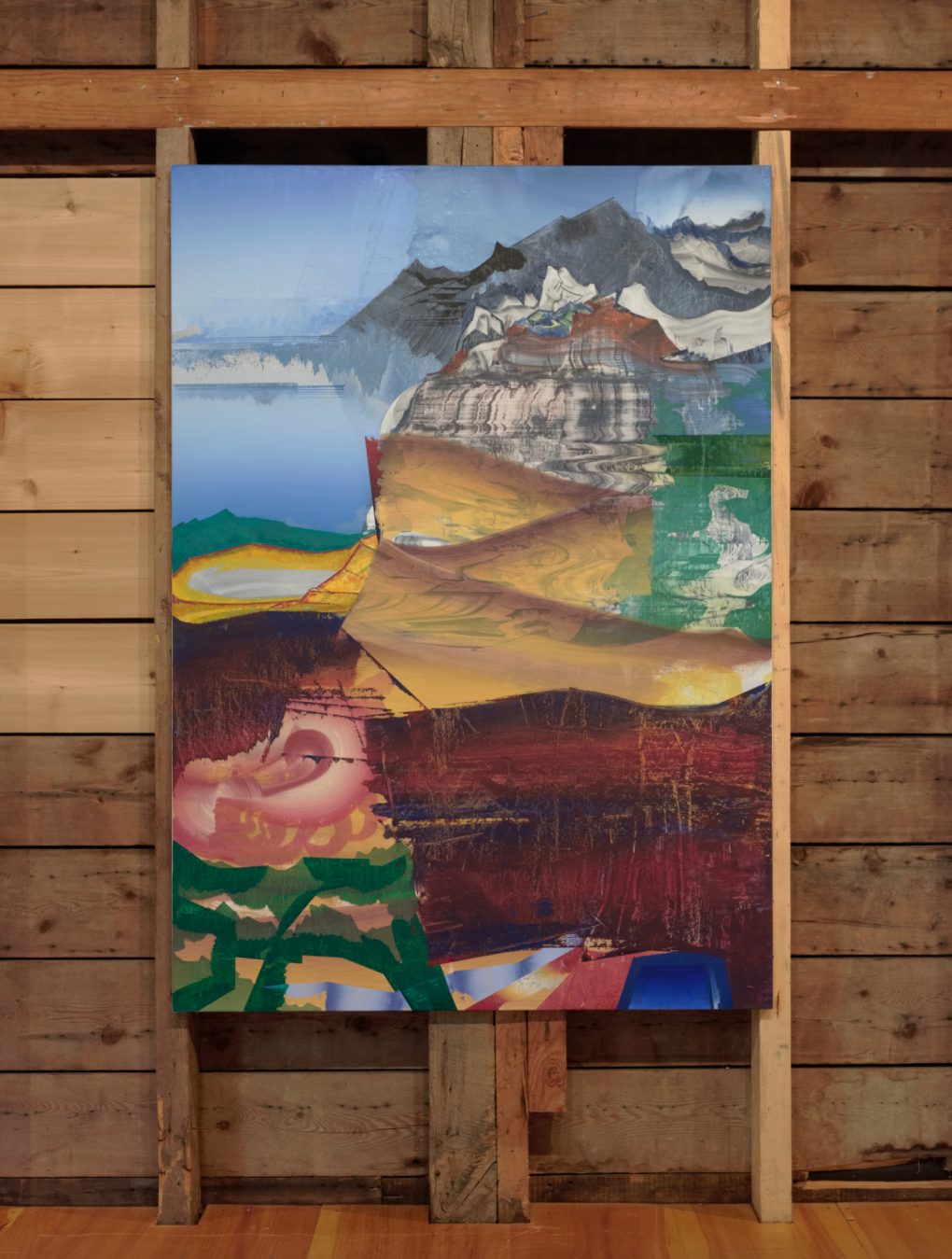
Beach Mountain 2015, Oil on linen, 76 x 54″Hiroyuki: The reference to landscape does work wonderfully to express the vast scale while also putting the element of time in a geological time frame. Combined with rich visual characters weaving narratives, the dramatic expression certainly brings out a strong emotional quality. But then, all that merely presents a challenge of actually constructing a functional whole which you manage very well. How does your painting start? Can you describe your making process? Also, were you always interested in colors? The striking use of colors can be seen as playful and absurd. In a way, it echoes your use of figures in your previous work.
Elliott: I start by brush-sketching on the canvas with a mixture of oil paint and graphite, and sometimes added colors, and I move without conscious intention for meaning, seemingly randomly, wiping away a lot. There is no pressure, because it is impossible to make a mistake at this stage. On one level, it is warming up my muscles, relaxing, emotionally diffusing, and at very least, spreading the tone on the canvas. If I make sweeping gestures that transverse the entire space, that will precede the final composition somehow, and foreshadow a theme. Motifs of shapes occur and through addition and subtraction some sensibility, personality and perspective arrive, and then I do more conscious analysis – editing, adding and tweaking to focus on the most interesting aspects and activities. For the benefit of the whole painting, some beautiful passages have to be sacrificed and painted over. Somehow, given enough time, a coherent vision arrives. I’ve made stop-action films of me making my paintings – and those let a viewer see how many decisions, reversals and revisions are involved, all of them impossible to predict.
I think I always had a sense of which colors got along beautifully with each other. I remember staring at children’s books as a toddler, immersed in them, like I was fascinated by their tonal harmonies. But not long after I began painting as an adult, I was looking for more excitement, and one way is to use colors that are unappealing on their own and to put them in with the naturally beautiful ones: the result is often very interesting. For example, the pink and green used to seem like a viscerally offensive combination to me, maybe because it reminded me of insects or rancid meat. But that is exactly where the meaning resides in color, in its good or bad associations with aspects of the world. A rainbow means connection and vomit means rejection — that’s good content even by itself, and then more dramatic when they conflict, or even better, if they somehow become unlikely friends.
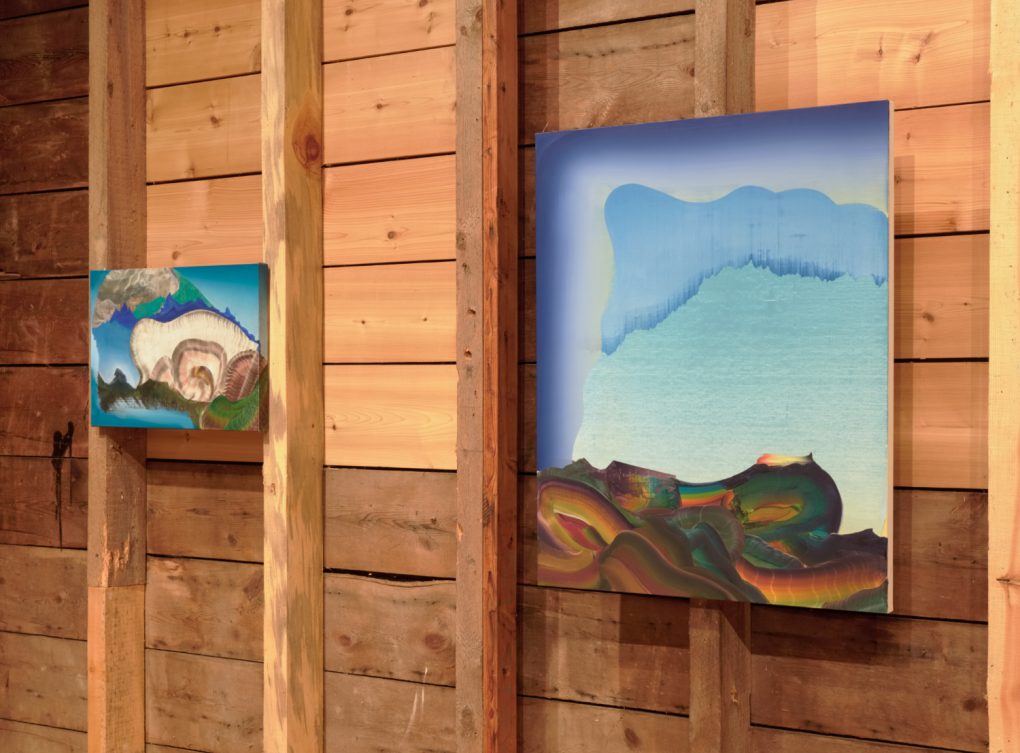
Fungus, 2018, Oil on linen, 16×24″ and Interesting Dirt, 2019, Oil on linen, 40×30″Hiroyuki: I just saw the videos that show the progress at your site. I can relate to the dialogue you create with the dynamics. I know that there are moments of excitement, disappointment, frustration, a sense of achievement and so on. And there is nothing like feeling that everything merges as the process culminates in presenting a cohesive wholeness. I don’t always feel it but sometimes the moment is indeed a catharsis. And it is also fascinating that the complex dynamics often reveal “unlikely friends”, as you say, it strikes us with unknown chemistry in viscerally concrete ways. It allows us to explore and makes us see unknown potentials explode before us. Strange thing isn’t it? Are there any activities that go with your studio practice? I mean, everything ultimately does, but things you are conscious about to keep you going.
Elliott: I realized in Rome, where my eyeballs were literally aching from looking so hard, that new environments absolutely stimulate what I will paint. I think it’s because when shapes and tones fill my short-term memory to capacity, it speeds up my decision-making, and the improvisations flow faster. So, my method is to just look around me with an innocent curiosity. I never deliberately seek out material for painting, nor do I sketch with the intention of inserting some phenomena directly into a painting. I have to be honestly, genuinely compelled by something to study it and enjoy it for itself, and then maybe, sooner or later, some essence of that thing I was paying attention to will emerge effortlessly at just the right time and place in a painting.

Interesting Dirt, 2019, Oil on linen, 40 x 30″Hiroyuki: I’ve heard artists talking about appreciating things around us visually. I always thought it was more about our attitude toward life in a general sense. But that makes sense. We learn and we are conditioned by our environment. Our actions and thoughts are affected by those. I was just talking to Eric Banks and he was also saying that he paints landscape paintings to inform himself about visual structures. And by choosing what to look at and how you look at it, you make a conscious decision (to a certain extent) as to where you sharpen your craft of expressing visually. That’s very interesting. It makes me think that artists should talk to each other more. Do you feel that you belong to an art community?
Elliott: Before a gallery represented my work in New York, I had no artist friends. But after 1989, when I was 29, I met many artists, mostly at first through another painter and sculptor named David Humphrey, who is very popular and active in the art community. He’s what the sociologists call a Super Connector.
Pierogi, the gallery where I show in NYC, is run and owned by a couple, an artist and a poet, so there is a lot of mutual respect, and also camaraderie among the artists who show there. The openings at Pierogi have always been packed with many artists. Joe Amrhein, the co-director, had a show at Postmasters Gallery in Tribeca last year. His paintings are great, but he also thinks of the gallery as a long running conceptual artwork about the moving messages of contemporary artists. There have been many historical shows there — it was the most active gallery in Williamsburg for decades, before they moved to the Lower East Side a few years ago. Its existence has documented the emergence of that neighborhood as a cultural community. Many of the artists that show there are my friends. And then I have made new friends, like you, on Instagram, which has really widened my horizons by introducing me to the work of friends of friends and talented people outside my generation, younger and older.
Hiroyuki: Elliott, thank you for sharing your insights and angles on many topics on art and art communities. Do you have anything to add to our conversation?
Elliott: Not really. Just thank you for this chance to think about my work from a fresh perspective, and for your interest. I think your work is great, and it has been enjoyable to compare notes on the shape of our different quests, and to see how our work has arrived at its present place.
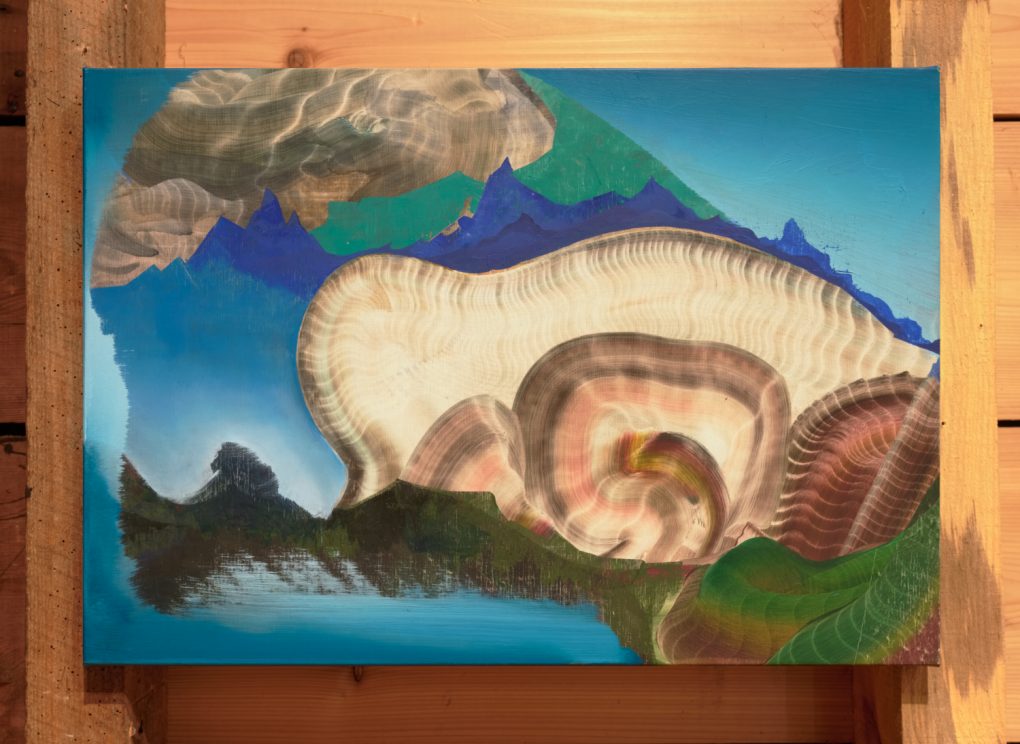
Fungus, 2018, Oil on linen, 16 x 24″Elliott Green (b. 1960 Detroit, Michigan) attended the University of Michigan, where he studied World Literature and Art History. He moved to New York City in 1981 and has been awarded a John Simon Guggenheim Foundation Fellowship, the Jules Guerin Rome Prize at the American Academy in Rome, a Pollock-Krasner Foundation Grant, a Marie Walsh Sharpe Foundation Residency, The Peter S. Reed Foundation Grant, a residency at the BAU Institute, Cassis, France, a MacDowell Colony Residency, and three residencies at Yaddo.
-
Three Painters at Duck Creek
I curated a painting show titled Three Painters at Duck Creek for the Arts Center at Duck Creek. The show went up on August 8th, 2020. It will be on view through August 30th, 2020.
Last year, there was an exhibition of my own paintings at the barn at Duck Creek. It was challenging, but it was also very rewarding. The warmth of wood, the irregular elements of patched walls and the natural elements of the historic site define this attractive venue. I live seven minutes away from there. I care about the place and I wanted to organize a show that people in the community could truly enjoy.
To me, the process of painting involves honesty, dedication and patience. It allows us tremendous freedom, but it also forces us to work with all elements with fairness, keen observation and a broad view to grasp the wholeness. We become one with the momentums, dynamics and mechanisms within the visual structure, which is built by our dialogues with the visual elements. Our paths become the work. The work therefore is authentic in a way, and it can capture a profound something that can resonate with our soul.
The work of the three painters that I selected for the show somehow share the above quality. They can be complex but they also convey solid cohesiveness. These three artists are versed with their own visual languages and they all speak to us in their own ways: but as they harmonize colors, shapes, lines, and layers, they reveal profoundness that goes beyond the framework that binds us as “civilized” beings, yet often as alienated beings. Their paintings have the power to move us unconditionally if we care to listen.
I thank Duck Creek for giving me an opportunity to organize this show. It has been rewarding on many grounds.
In order to introduce the artists to the Duck Creek audience, I interviewed the three painters. We talked about how they get started, their processes, their philosophy on art, and more.
Conversation with Elliott Green
Conversation with Sean Sullivan
At the Duck Creek barn, the interviews are available in a booklet format.
Read the booklet in a pdf format. You can also print your own booklet.
Elliott Green (b. 1960 Detroit, Michigan – eg@elliottgreen.com). He attended the University of Michigan, where he studied World literature and Art history. He moved to New York City in 1981 and has been awarded a John Simon Guggenheim Foundation Fellowship, the Jules Guerin Rome Prize at the American Academy in Rome, a Pollock-Krasner Foundation Grant, a Marie Walsh Sharpe Foundation Residency, a The Peter S. Reed Foundation Grant, a residency at the BAU Institute, Cassis, France, a MacDowell Colony Residency, and three residencies at Yaddo.
Eric Banks (b. 1954 Brooklyn, NY – ericbanks54@gmail.com) Brooklyn-native, Banks lives and works in Rhinebeck, NY. In 1977, he obtained his B.A. from Queens College of the City University of New York, NY. After receiving his M.F.A. from Maryland Institute College of Art, Hoffberger School of Painting in 1981, Banks was awarded the Pollock-Krasner Foundation Grant, Edward Albee Foundation Grant, and Walters Fellowship. Banks has exhibited nationally; most-recently, his work has been on view at NYC galleries, such as Amos Eno Gallery and Sideshow Gallery.
Sean Sullivan (b. 1975 Bronx, NY – paradepimlicopearl@gmail.com) lives and works in the Hudson Valley, NY. He received the NYSCA/NYFA Artist Fellow in Printmaking/Drawing/Book Arts Grant in 2017. He has participated in group exhibitions at the Samuel Dorsky Museum of Art at SUNY New Paltz, NY; the Markus Luttgen Gallery, Cologne, Germany; and the Museum for Drawing, Huningen, Belgium.
Here are images from the show.
-
Images from Drive By Art
Here are some images from Drive By Art.
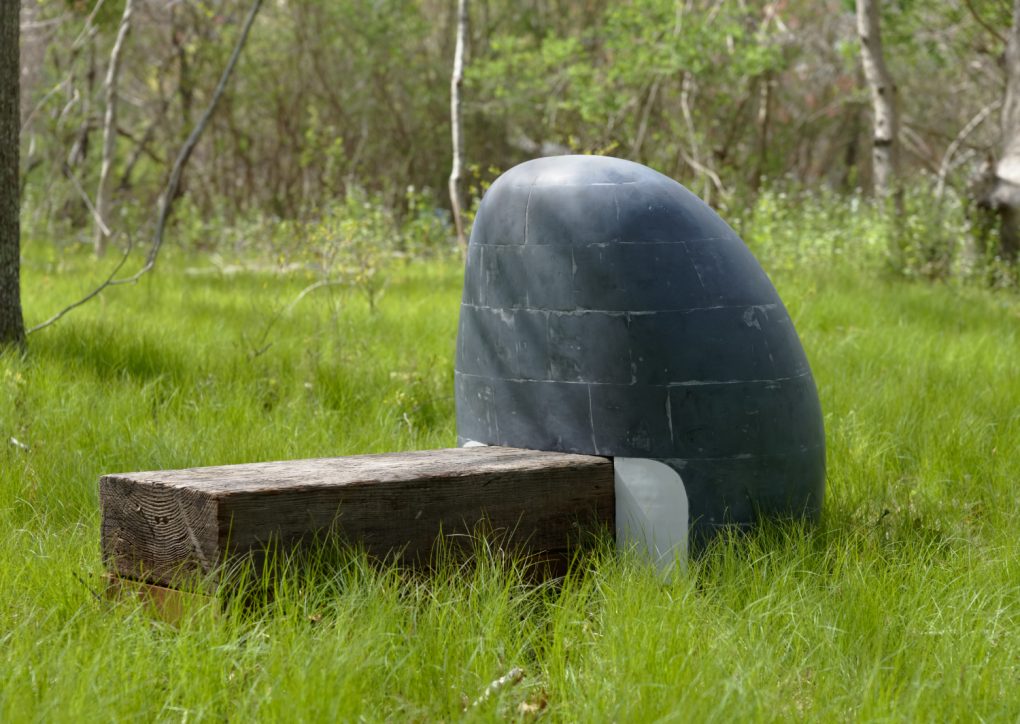
#89, painted resin and wood, 48” x 20 ½” x 27”, 2020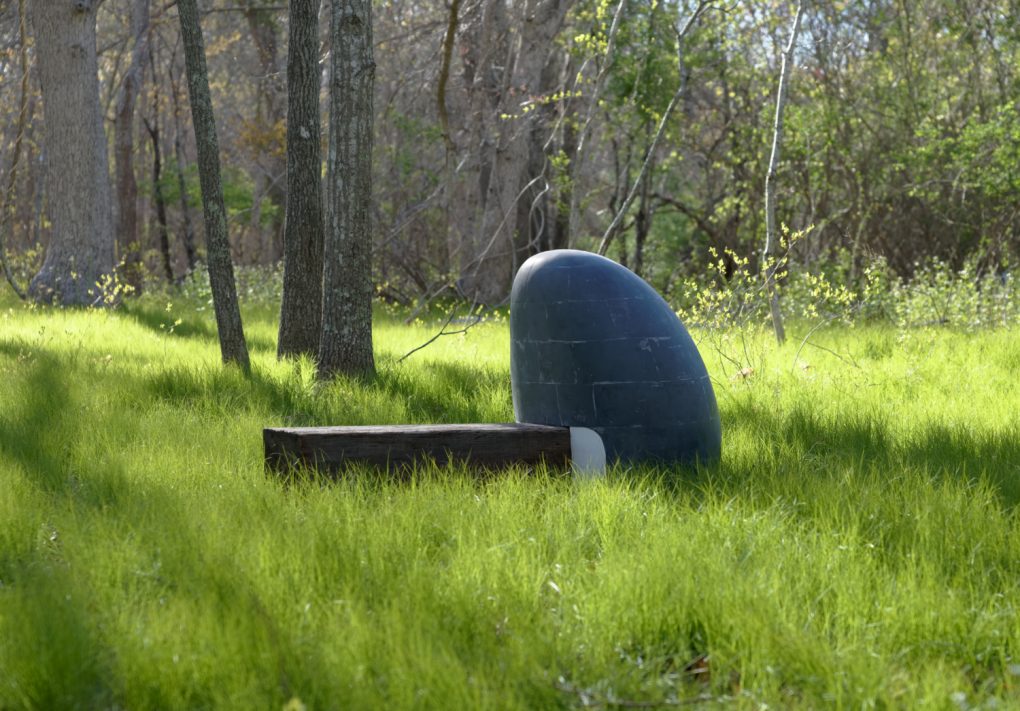
#89, painted resin and wood, 48” x 20 ½” x 27”, 2020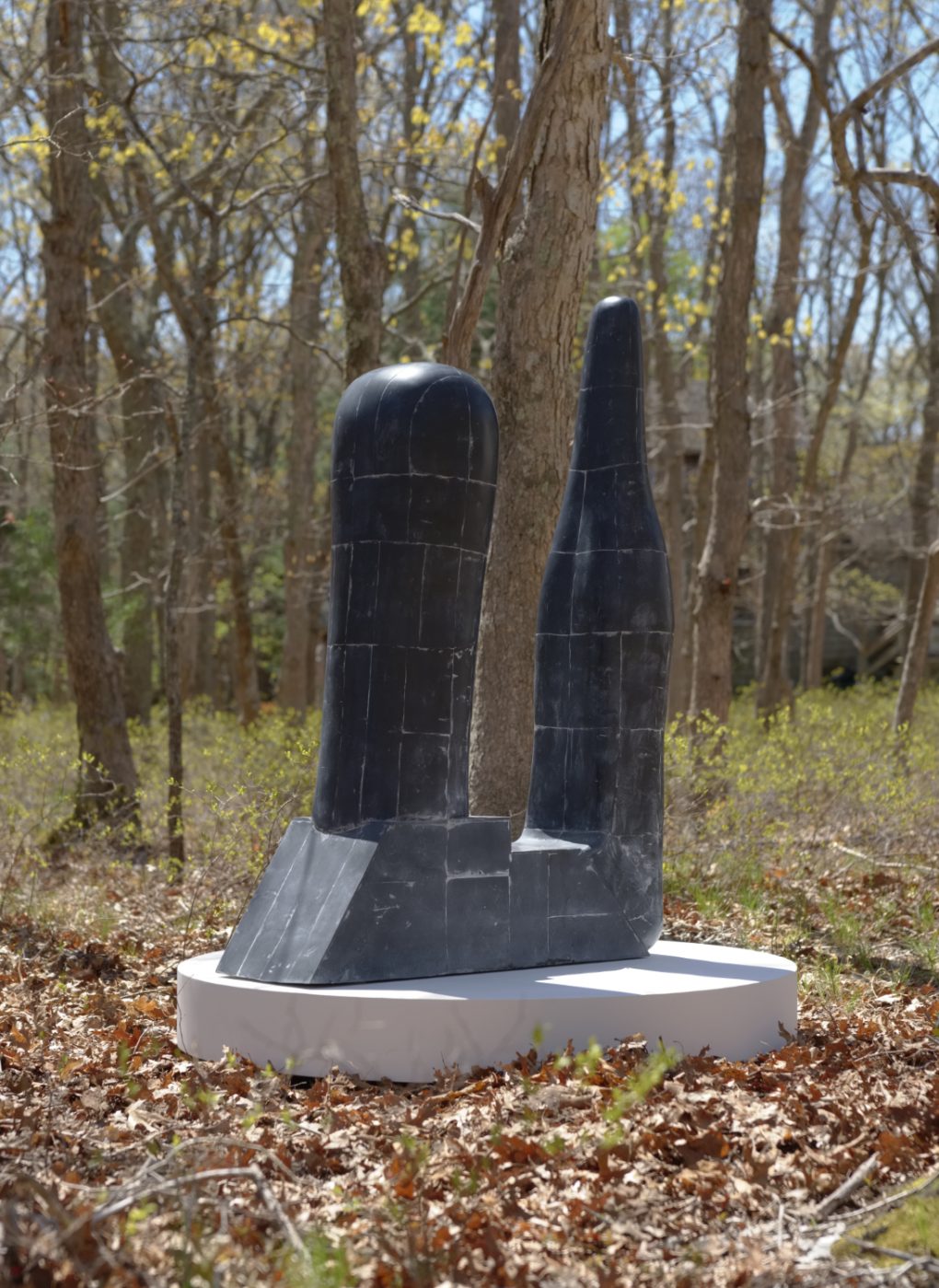
#87, 54” x 40” x 11 3/4”, pigmented resin, 2019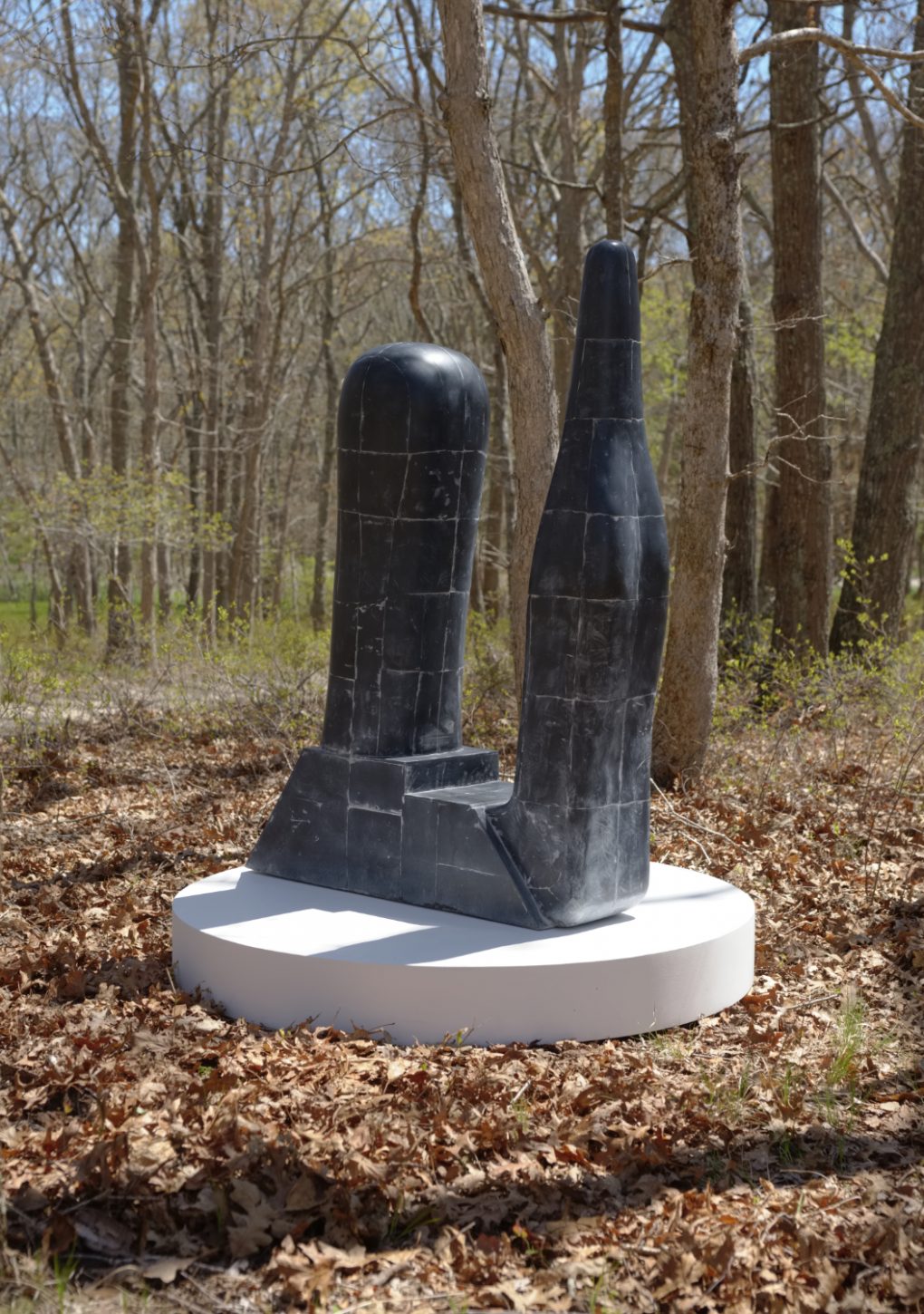
#87, 54” x 40” x 11 3/4”, pigmented resin, 2019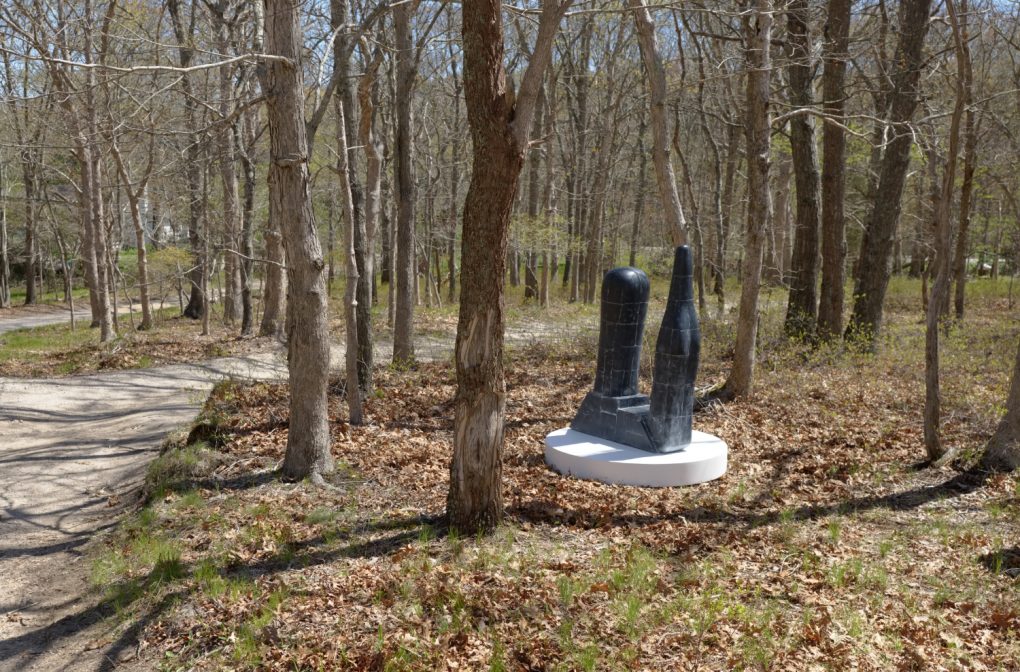
#87, 54” x 40” x 11 3/4”, pigmented resin, 2019
#72, painted resin, 28″ x 53″ x 39″, 2011-13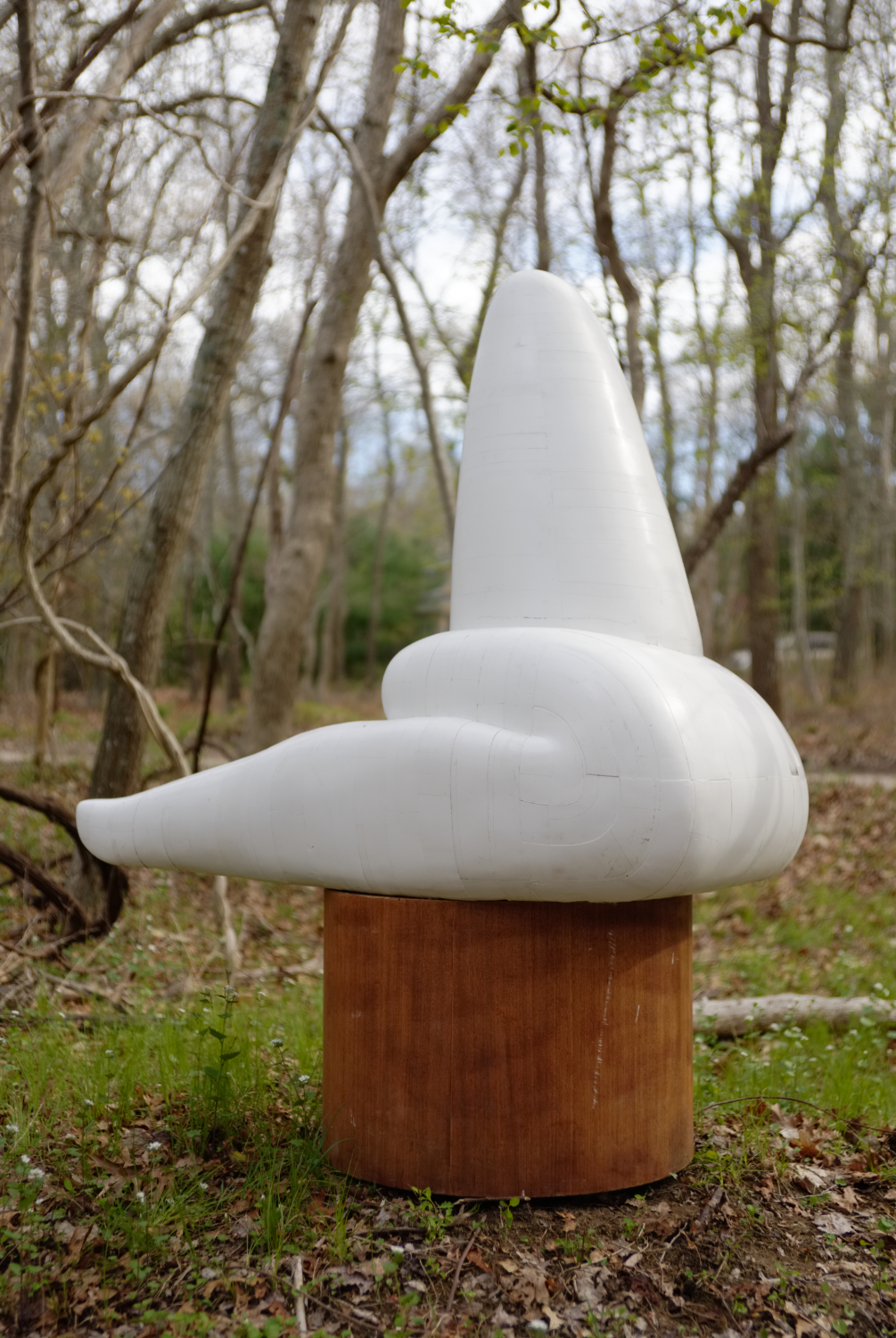
#72, painted resin, 28″ x 53″ x 39″, 2011-13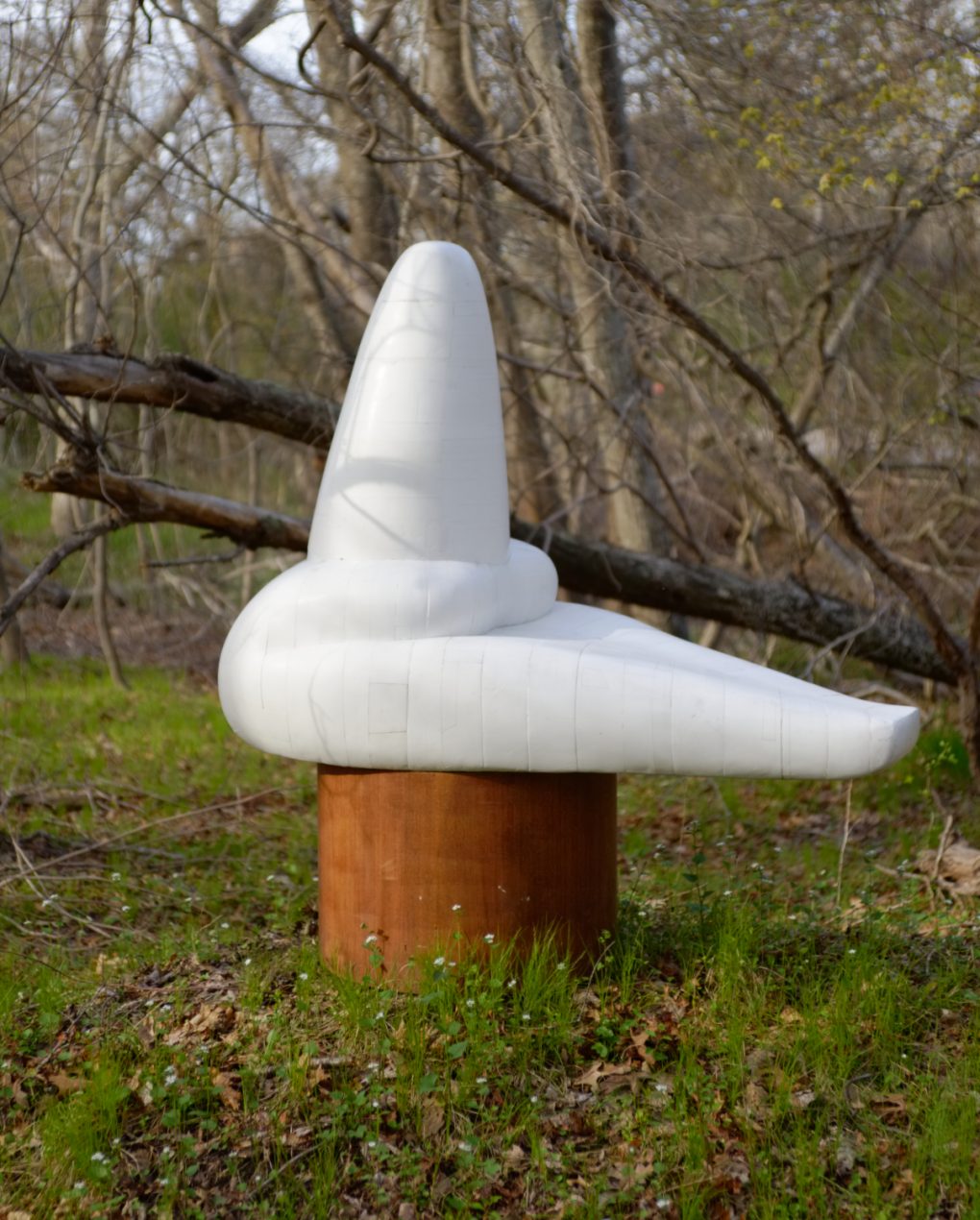
#72, painted resin, 28″ x 53″ x 39″, 2011-13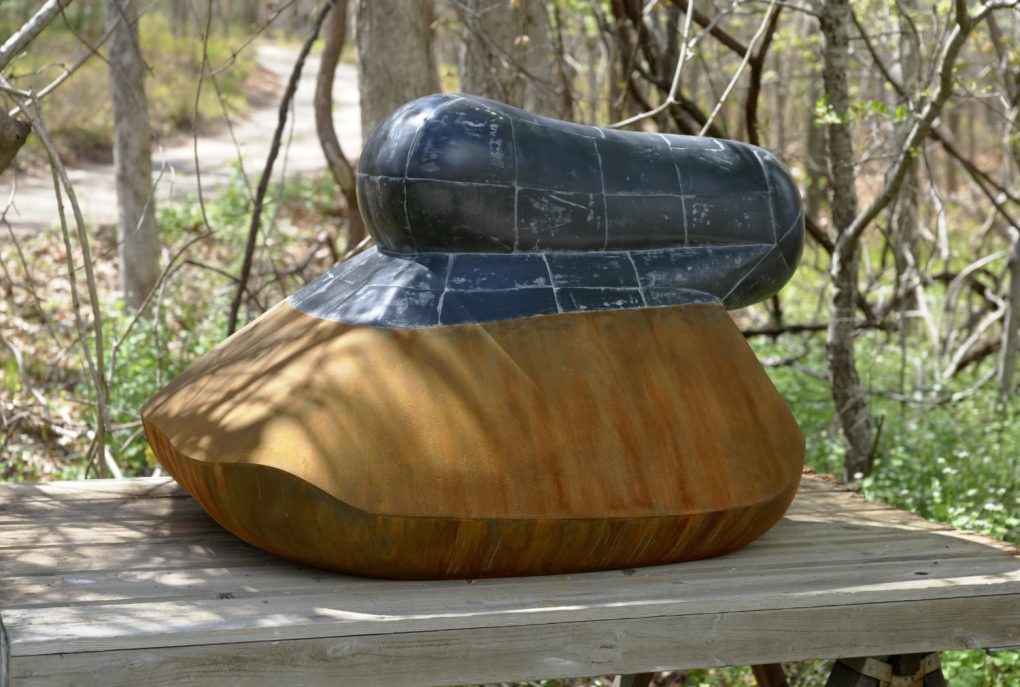
#88, painted resin, 47” x 29” x 41”, 2016-20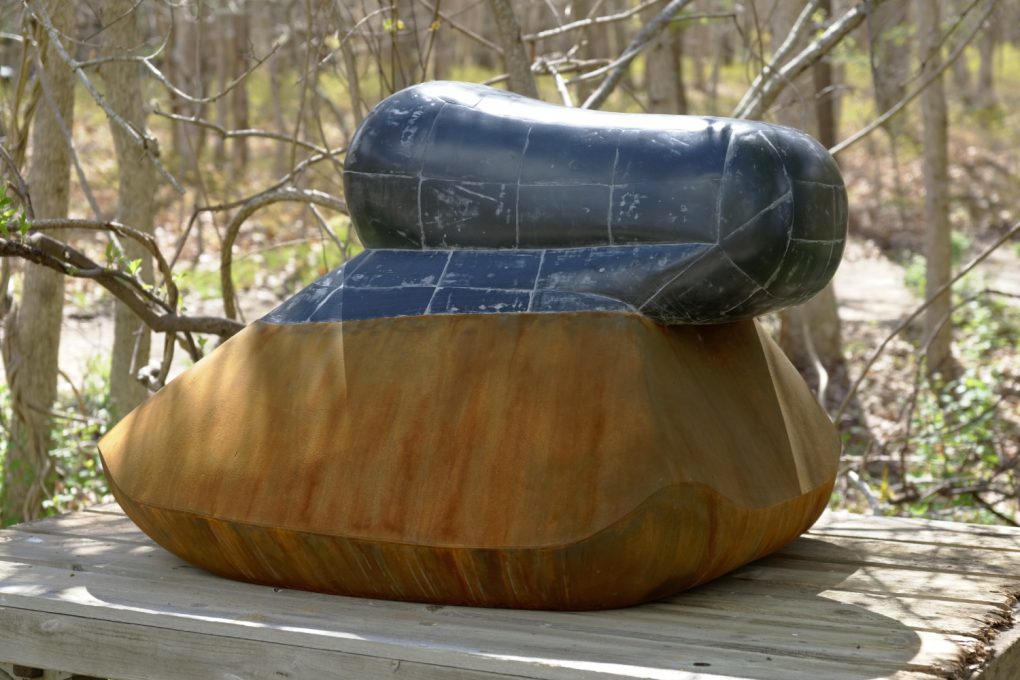
#88, painted resin, 47” x 29” x 41”, 2016-20
#88, painted resin, 47” x 29” x 41”, 2016-20More info for Drive by Art, an art event organized by Warren Neidich
My recent essay was made available during the event:
Lockdown Therapy for Capitalism
by Hiroyuki Hamada / April 28th, 2020 -
Drive By Art
In Art, Artist, Capitalism, creative process, Culture, Exhibition, Installation, new work, News, Sculpture onI’ve been asked to participate in an outdoor exhibition titled Drive By Art organized by Warren Neidich. It takes place on the eastern end of Long Island where I’m located. Artists come up with unorthodox ways to show art, and hopefully the event generates constructive discussions on the extraordinary situation we are in. This gives me an opportunity to try placing three of my sculptures outside, which I haven’t done before. Yesterday, my wife and I looked around the woods by our house and discussed how we go about it. We went ahead and placed one of the pieces at a spot my wife noticed. It was eye-opening to see the piece liberate itself at the spot. What a way to interact with nature. Of course, this is hardly new—countless artists prefer to show their work outside—but it’s better late than never. Oh well. We plan to place one right by the road,and we haven’t decided about the last one yet. Pretty exciting. The event takes place on May 9th and 10th, Noon to 5pm. Around 50 artists will participate. I will also make my recent essay available hoping that it will generate some discussions among us.
Please go to the website for more info:
-
Images from Bookstein Projects show
Here are some images from the Bookstein Projects show. The show is up till February 15, 2020.
Bookstein Projects60 East 66th Street, 3rd Floor, New York, NY 10065Tel (212) 750-0949info@booksteinprojects.com................. -
A New Piece, #87
Here are images of a new piece, #87. After going through many stages for two 1/2 years, it finally presents itself with a cogent presence of its own. The piece will be in a solo show opening on January 9th, 2020 at Bookstein Projects in NYC. The reception is on January 9th, 6-8pm.
#87, 54” x 40” x 11 3/4”, pigmented resin, 2019
